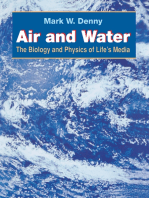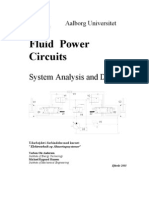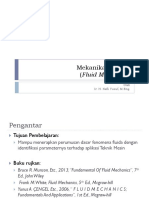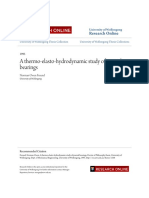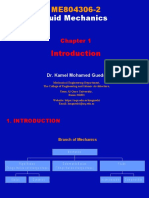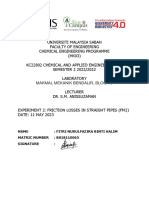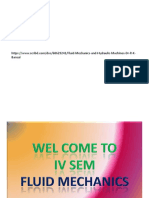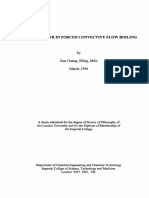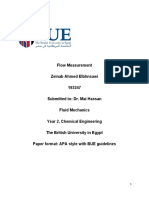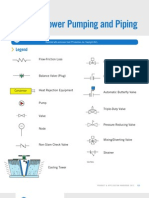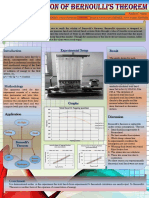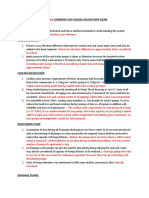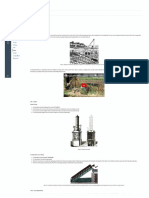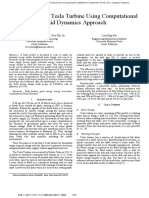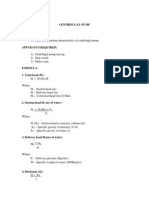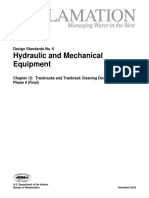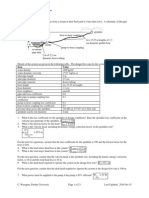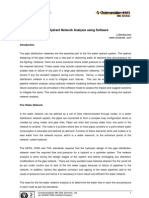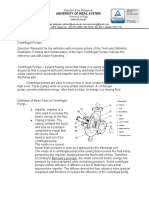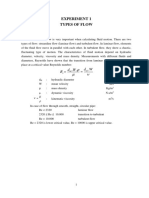Mee2161 Fluid Mechanics - 2021
Mee2161 Fluid Mechanics - 2021
Uploaded by
dany rwagatareCopyright:
Available Formats
Mee2161 Fluid Mechanics - 2021
Mee2161 Fluid Mechanics - 2021
Uploaded by
dany rwagatareOriginal Description:
Original Title
Copyright
Available Formats
Share this document
Did you find this document useful?
Is this content inappropriate?
Copyright:
Available Formats
Mee2161 Fluid Mechanics - 2021
Mee2161 Fluid Mechanics - 2021
Uploaded by
dany rwagatareCopyright:
Available Formats
MEE2161 Fluid mechanics
MEE 2161 FLUID MECHANICS
I. INTRODUCTION
1.1 Three states of matter
1.1.1 Solid state
1.1.2 Liquid state
1.1.3 Gaseous state
1.2 Fluid mechanics in engineering
1.2.1 Definition of a fluid
1.2.2 Definition of fluid mechanics
1.2.3 Definition of hydraulics
1.2.4 Application of fluid mechanics
1.2.5 Solving problems in fluid mechanics.
II. PROPERTIES OF FLUIDS
2.1 Fluid density
2.1.1 Mass density ( )
2.1.2 Weight density ( )
2.1.3 Specific volume ( )
2.1.4 Specific gravity (S)
2.2 Fluid viscosity
2.2.1 Definition of viscosity
2.2.2 Shear stress exerted on a fluid
2.2.3 Dynamic viscosity and Newton’s law
2.2.4 Kinematic viscosity
2.2.5 Effects of temperature on viscosity
2.2.6 Classification of fluids
2.3 Thermodynamic properties
2.4 Compressibility and elasticity of fluid
2.5 Surface tension and capillarity
2.6 Vapour pressure and cavitation
2.7 Physical properties of water
III. FLUID STATICS
3.1 Pressure of a liquid
3.2 Hydrostatic pressure
3.2.1 Hydrostatic law
3.2.2 Pressure head for a liquid
3.2.3 Hydrostatic paradox
3.3 Pascal’s law
3.3.1 Pascal’s theorem
3.3.2 Pascal’s law application
3.4 Pressure variation in immiscible fluids
Lecture notes by: Eng. Leonard NZABONANTUMA, June, 2021 Page 1
MEE2161 Fluid mechanics
3.5 Absolute and gauge pressures
3.6 Pressure measurement devices
3.6.1 Barometers
3.6.2 Manometers
3.6.3 Mechanical gauges for pressure measurement
3.7 Hydrostatic forces on surfaces
3.7.1 Horizontal surfaces
3.7.2 Vertical surfaces
3.7.3 Inclined surface
3.7.4 Curved surface
3.7.5 Dams
IV FLUID DYNAMICS
4.1 Concepts of fluid flows
4.1.1 Fluid flow
4.1.2 Discharge and mean velocity
4.1.3 Types of fluid flow
4.1.4 Types of flow lines
4.2 Continuity equation
4.3 Bernoulli equation
4.4 Momentum equation
4.5 Energy equation
V FLOW MEASUREMENT
5.1 Generalities on flow measurements
5.2 Pressure measurement
5.3 Velocity measurement
5.3.1 Flow through pipes
5.3.2 Flow through open channels
5.4 Discharge through pipes
5.4.1 Venturimeter
5.4.2 Orificemeter
5.5 Flow through orifices and mouthpieces
5.5.1 Flow through orifices
5.5.2 Orifices coefficients
5.5.3 Experimental determination of coefficients of orifices
5.5.4 Mouthpieces
5.6 Flow over notches and weirs
5.6.1 Definition
5.6.2 Discharge over rectangular notches or weirs
5.6.3 Discharge over triangular notches or weirs
5.6.4 Discharge over trapezoidal notches or weirs
5.6.5 Discharge over stepped notches
5.6.6 Discharge over Cipoletti weirs
Lecture notes by: Eng. Leonard NZABONANTUMA, June, 2021 Page 2
MEE2161 Fluid mechanics
5.6.7 Discharge over ogee weirs
5.6.8 Discharge over submerged weirs
5.6.9 Discharge over broad-crested and narrow crated weirs
5.6.10 Approach velocity for notches and weirs
5.6.11 Francis formula for rectangular weirs.
5.7 Discharge through a venturiflume
5.7.1 Definition
5.7.2 Expression of discharge through a venturiflume.
VI HYDRAULIC MODELS AND SIMILTUDE
6.1 Definition of dimensional analysis
6.2 Fundamental quantities and fundamental dimensions
6.3 Dimensional homogeneity
6.4 Dimensional number
5.4.1 Reynolds number (Re)
5.4.2 Froude number (Fr)
5.4.3 Euler’s number (Eu)
5.4.4 Weber number (We)
5.4.5 Mach number (Ma)
6.5 Methods of dimensional analysis
6.5.1 Rayleigh’s method
6.5.2 Buckingham’s method
6.6 Model analysis
6.6.1 Definition
6.6.2 Similitude
6.6.3 Similarity
6.6.4 Scale effects in models.
Lecture notes by: Eng. Leonard NZABONANTUMA, June, 2021 Page 3
MEE2161 Fluid mechanics
I INTRODUCTION
Fluid mechanics is concerned with the behavior of materials which deform without
limit under the influence of shearing forces. Even a very small shearing force will
deform a fluid body, but the velocity of the deformation will be correspondingly
small. This property serves as the definition of a fluid: the shearing forces necessary
to deform a fluid body go to zero as the velocity of deformation tends to zero. On
the contrary, the behavior of a solid body is such that the deformation itself, not the
velocity of deformation, goes to zero when the forces necessary to deform it tend to
zero.
1.1 Three states of matter
1) Solid state;
2) Liquid state;
3) Gaseous state.
(i) A solid can resist to tensile, compressive and shear stresses up to a
certain limit.
(ii) Liquids = incompressible fluids
The liquids under ordinary conditions are quite difficult to compress and
therefore they are considered as incompressible fluids.
(iii) Gases = compressible fluids
Gases can be compressed much rapidly under action of external pressure
and when the external pressure is removed, the gases tend to expand
indefinitely.
That is why they are known as compressible fluids.
1.2 Fluid mechanics in Engineering.
1.2.1 Definition of a fluid.
Fluid (= liquid or gas) is any substance which is capable of flowing.
1.2.2 Definition of fluid mechanics.
Fluid mechanics is that branch of engineering science which is concerned
with forces and energy generated by fluids at rest and in motion.
1.2.3 Definition of hydraulics
Hydraulics is that branch of engineering science which deals with water at
rest or in motion.
1.2.4 Applications of fluid mechanics.
Lecture notes by: Eng. Leonard NZABONANTUMA, June, 2021 Page 4
MEE2161 Fluid mechanics
The study of fluid mechanics involves application of the fundamental
principle of mechanics and some thermodynamic aspects to develop a
quantitative understanding and a qualitative analysis that an engineer can
apply to design or to evaluate equipment and processes which involve
fluids.
Some applications of fluid mechanics can be illustrated in the following fields:
(1) Fluid transport
e.g: home and city water supply system, plant piping, natural gas and
agricultural pipelines…
(2) Energy generation
e.g: Typical energy conversion devices such as steam turbines, gas
turbines, hydroelectric power plant…
(3) Environmental control (air conditioning system)
e.g: 75% of American homes are heated by forced-air system
(4) Transportation
e.g: generation of lift force by air motion over air plane wings,…
1.2.5 Solving problems in fluid mechanics.
1) Sketch
2) Given data
3) Required
4) Formula
5) Numerical values with units and interpolation.
NOTE: - The international system of units abbreviated as SI units is formed by the
following base units: kg (mass); m (length); s (time); 0K (temperature);
A (current).
Hence the system MKSA.
- Some derived units are:
1N = 1kg.m/s2
1J = 1N.m
1W = 1J/s
1Pa = 1N/m2
Lecture notes by: Eng. Leonard NZABONANTUMA, June, 2021 Page 5
MEE2161 Fluid mechanics
- Multiple and submultiples of various SI units
Examples: 1GN = 109N
1MPa = 106 Pa
1KN = 103N
1mm = 10-3m
1 m = 10-6m
1nm = 10-9m
- Some conversion factors
1 mile = 1mi = 1.609 x 103m
1 foot = 1ft = 0.3048m ( 1 = 12 ; 1 = 2.54cm = 1inch)
1yard = 1yd = 36
1USgallon = 1USgal = 3.79 L
1UKgallon = 1UKgal = 4.546 L
1pound = 1lb = 0.4536kg
1dyne = 10-5N (C.G.S system units)
1horsepower = 1HP = 745.7W
1psi = 6895Pa (=1 pound per square inch)
1acre = 4047m2
1bar = 1atm = 105 Pa
1poise = 1po = 10-1 N.s/m2 ( = dynamic viscosity = absolute viscosity of
fluid) 1stoke = 1st = 10-4 m2/s ( = Kinematic viscosity = )
1kgf = 9.81N
Lecture notes by: Eng. Leonard NZABONANTUMA, June, 2021 Page 6
MEE2161 Fluid mechanics
II. PROPERTIES OF FLUIDS
2.1 Fluid density
2.1.1 Mass density ( ) = Specific mass.
m
= mass per unit volume ( ) at standard temperature (T0 = 273 0K = 00 C)
V
m
i.e: = ; m (kg) ; V = (m3) (kg/m3).
V
Example: w = 1000kg/m3 (water at 40C)
a = 1.293kg/m3 (air at 00C)
2.1.2 Weight density ( ) = Specific weight
W
= The weight per unit volume ( ) at the standard temperature and pressure
V
W
i.e.: = ; W (KN); V (m3) (KN/ m3)
V
W m.g
NOTE: = = = g
V V
e.g.: w = 103 kg/ m3 w = 9.81 KN/ m3
2.1.3 Specific volume ( )
1 1
= The volume per unit mass of fluid i.e.: ; (kg/ m3) (m3 /kg)
m
2.1.4 Specific gravity (S)
SpecificWeightof the fluid
S
SpecificWeightof a referencefluid
NOTE: The reference fluid of liquids = pure water at 40C;
The reference fluid of gases = pure air at 00C.
liquid
i.e : S liquid = ; w 1000 kg/m3 (at 40C)
wat 4 C w
0
gas
S gas = ; a = 1.293 kg/m3 (at 00C)
air at 0 C0
a
NOTES: 1) , and S are the forms of density.
2) Pure water at 40C is also the reference matter of solids.
Lecture notes by: Eng. Leonard NZABONANTUMA, June, 2021 Page 7
MEE2161 Fluid mechanics
solid
i.e: S solid =
w at 4 C
0
Example: A liquid has a volume of 6m3 and its weight is 44 KN
Determine: i) Its mass density ( )
ii) Its weight density ( )
iii) Its specific volume ( )
iv) And its specific gravity (S)
Solution
m W W 44 103 N
i) ;m 747.5kg / m 3
V g g V 9.81 kg 6m
N 3
W 44
ii) 7.333KN / m 3
V 6
V 1 1
iii) 1.338 10 3 m 3 / kg
m 747.5
747.5
iv) S = 0.748
w w 1000
2.2 Fluid viscosity
2.2.1 Definition of viscosity
Viscosity: the internal friction of a fluid.
(= the property of a fluid which determines the shearing resistance of any fluid)
NOTE: Both liquid and gases exhibit viscosity.
2.2.2 Shear stress exerted on a fluid
(1) Velocity distribution
v max v
For a triangular velocity distribution:
l y
Lecture notes by: Eng. Leonard NZABONANTUMA, June, 2021 Page 8
MEE2161 Fluid mechanics
vmax dv y vmax
i.e.: v y y
l dy l
F
(1) If A is the area of the fluid over which the force F is applied, then: ;
A
Where = the shear stress applied on the fluid.
2.2.3 Dynamic viscosity and Newton’s law
The Newton’s law of viscosity states that “The shear stress on a fluid
dv
element layer is directly proportional to the rate of the angular deformation ”
dy
dv
i.e.: (Newton’s law) ; = dynamic viscosity or absolute viscosity of
dy
the fluid.
2.2.4 Kinematic viscosity
; N s / m 2 ; kg / m 3 m 2 / s
1 stoke =10-4m2/s
1 poise = 10-1 N.s/m2
Example: (1) 20 (water) = 1 centipoise = 10-2 poise = 10-3 poise N.s/m2
water 106 m 2 / s
(2) (air) = 1.78 x 10-5 N.s/m2
Exercices
1) Show that N .s / m 2
2) Show that m 2 / s
Solution
1) .
y N m m N .s / m 2
2
v m
s
kg m
kg mss/2m
2
N .s
m2 / s
2
2)
m 3
kg
m3
2.2.5 Effects of temperature on viscosity
(1) The viscosity of liquids decreases with the increase of temperature
i.e fo a liquid: If T increases then decreases;
Lecture notes by: Eng. Leonard NZABONANTUMA, June, 2021 Page 9
MEE2161 Fluid mechanics
(2) The viscosity of gases increases with the increase of temperature
i.e for gases:
If T Increases then increases.
2.2.6 Classification of fluids
dv
(1) Newtonian fluids ( ) = Fluid which follow the Newton’s law of
dy
viscosity i.e Fluid whose viscosity does not change with the rate of deformation.
Examples; water, air, kerosene …
(2) Non Newtonian fluids = fluids which do not follow the linear relationship
dv
between and the rate of angular deformation .
dy
Example: mud flows, polymer solutions, blood, etc….(These fluids are generally
made of complex mixtures)
(3) Ideal fluids = incompressible fluids with zero viscosity and no surface tension
NOTE: In true sense, no such fluids exist in nature. However, fluids which have
low viscosities such as water and air can be treated as ideal fluids.
(4) Real fluids = Fluid which have viscosity, surface tension and compressibility.
NOTE: All fluids in actual practice are real fluids.
Example
Lecture notes by: Eng. Leonard NZABONANTUMA, June, 2021 Page 10
MEE2161 Fluid mechanics
A plate 0.05mm distant from a fixed plate moves at 1.2 m/s and requires a force of
2.2N/m2 to maintain the same speed.
Determine the fluid viscosity between the plates.
Solution:
dv dv v v 0
;
dy dy y l 0
v l
i.e
l V
l v
l
i.e ; 2.2 N / m 2
v
l = 0.05x10-3m
v = 1.2m/s
5 10 5
2.2 Ns / m 2
1.2
= 9.17x10-5 Ns/m2
( 91.7 105 poise )
2.3 Thermodynamic properties.
Characteristic equation of a state of a perfect gas:
(i) pV nRT
Where p = absolute pressure, p(N/m2)
V = volume of m kg of gas, V(m3)
T = absolute temperature, T(0K)
n = number of gas moles, n (moles)
R = universal gas constant, R = 8314.3 Nm/mole 0k
(ii) When the change in the state of the fluid system is affected at constant pressure,
the process is known as isobaric process (= constant pressure process)
Lecture notes by: Eng. Leonard NZABONANTUMA, June, 2021 Page 11
MEE2161 Fluid mechanics
V
Const. (Charles’s Law)
T
(iii) When the change in the state of the fluid system is affected at constant
temperature, the process is known as isothermal process.
pV Const (Boyle’ Law)
(iv) When no heat is transferred to or from the fluid during the change in the state
of the fluid system, the process is called adiabatic process.
pV const.
cp
Where
cv
c p Specific heat of the gas at constant pressure
c v Specific heat of the gas at constant volume
(The specific heat of a solid or a liquid = the heat required to raise a unit mass
through one degree of temperature; for a gas two specific heat are defined : c p & c v
)
2.4 Compressibility and elasticity of fluids.
Consider a cylinder fitted with a piston as shown in the figure below:
(i) Bulk modulus of elasticity (K)
The bulk modulus of elasticity of a fluid is defined as:
dp
K ; K (GN/m2) ; 1GN/m2 = 109N/m2
dV
V0
Lecture notes by: Eng. Leonard NZABONANTUMA, June, 2021 Page 12
MEE2161 Fluid mechanics
(i.e When the pressure of a fluid is increased to p + dp, the volume of that fluid
dV
decreases from V0 to V0 + dV. Hence the volumetric strain is - )
V0
e.g: Kwater = 2.07 x 106 KN/m2 = 2.07 GN/m2
Kair = 101.3 KN/m2
(ii) Compressibility of a fluid ( K )
The property by virtue of which fluids undergo a change in volume under the
action of external pressure is known as compressibility.
1
Compressibility : K
K
Example:
When the pressure of a liquid is increased from 3.5MN/m2 to 6.5MN/m2, its
decrease in volume is 0.08 %.
Determine the bulk modulus of elasticity of that liquid.
Solution:
dp
K ; dp = 6.5 – 3.5 = 3.0 MN/m2
dV
V0
dV
= 0.08 % = 0.08/100 = 8 x 10-4
V0
3 106
K 4
N / m2
8 10
= 3.75 x 109 N/m2
= 3.75 GN/m2
2.5 Surface tension and capillarity
2.5.1 Surface tension
Cohesion = intermolecular attraction between molecules of the same
liquid.
Adhesion = attraction between the molecules of a liquid and the
molecules of a solid boundary surface in contact with the liquid.
Surface tension ( ) = the tensile force acting on the surface of a liquid in
contact with a gas or on the surface between two immerssible liquids.
Lecture notes by: Eng. Leonard NZABONANTUMA, June, 2021 Page 13
MEE2161 Fluid mechanics
The magnitude of this force ( ) per unit length of the free surface is
expressed as (N/m).
NOTE: Surface tension is due to cohesion between particles at the same
surface.
2.5.2 Capillarity.
Capillarity = the phenomenon of rise or fall of a liquid surface in a small
tube d ≤ 12.5mm (The rise of liquid surface is known as capillarity rise
while the fall of the liquid surface is capillary depression).
(1) Expression of capillary rise
If the glass is immersed in water, the level of water in the tube will be higher
than the outside liquid:
4 cos
Where: h (with )
gd 2
NOTE: The value of between water and clean glass tube is approximately
equal to zero, i.e. cos 1 for water.
4
Hence: hwater
gd
(2) Expression for the capillary fall
if the glass is immersed in mercury, the level of mercury in the tube will be
lower than the outside liquid:
4 cos
Where: h (with )
gd 2
Lecture notes by: Eng. Leonard NZABONANTUMA, June, 2021 Page 14
MEE2161 Fluid mechanics
NOTE: The value of for mercury and a glass tube is = 1280, say = 1300
Example:
Determine the capillarity rise in a glass tube of 2.5mm of diameter when immersed
vertically in:
(i) Water
(ii) Mercury
NOTE: The surface tension for water is = 0.0725 N/m and the angle of
contact of water with a glass tube is water = 00
For mercury, = 0.52 N/m when it is in contact with air.
The specific gravity of mercury is 13.6 and the angle of contact of mercury with a
glass tube is =1300
Solution.
(i) capillary rise for water ( = 00)
4
hwater
gd
4 0.075
=
1000 9.81 2.5 10 3
m
= 0.0118
= 1.18 cm
(ii) Capillary rise for mercury ( =1300)
4 cos
h
gd
4 0.52 cos1300
=
13600 9.81 2.5 10 3
m
= -0.004 m
= -0.4 cm
(The negative sign indicates the capillary depression)
Lecture notes by: Eng. Leonard NZABONANTUMA, June, 2021 Page 15
MEE2161 Fluid mechanics
2.6 Vapour pressure and cavitation
2.6.1 Vapour pressure
All liquids have a tendency to evaporate: molecules are continuously
projected from the free surface to the atmosphere.
These ejected molecules are in gaseous state and exert their own partial
vapour pressure on the liquid surface:
This pressure is known as the vapour pressure (pv)
If the surface above the liquid is confined, the partial vapour pressure
exerted by the molecules increase till the rate at which the molecule re-enter
the liquid becomes equal to the rate at which they leave surface.
At the equilibrium state, the vapour pressure is called the saturated vapour
pressure (pvs).
2.6.2 Cavitation
If the pressure on the liquid surface is lower than the saturation vapour pressure,
boiling takes place (i.e. the cavitation phenomenon).
(1) Definition of cavitation
Cavitation: the phenomenon of formation of vapour bubbles of flowing liquid
in a region where the pressure of the liquid falls below its vapour pressure.
(2) Effects of cavitation
Lecture notes by: Eng. Leonard NZABONANTUMA, June, 2021 Page 16
MEE2161 Fluid mechanics
1. When the vapour bubbles collapse, a very high pressure is created which
can damage the metallic surface.
2. Due to sudden collapse of vapour bubbles, cavities are formed on the
surfaces and considerable noise and vibrations are produced.
3. The efficiency of turbines and centrifugal pumps decrease due to
cavitation.
(3) Precautions against cavitation
The pressure of the flowing liquid in any part of the hydraulic system must
be kept above its vapour pressure.
The special material or coatings such as aluminium-bronze and stainless
steel, which are cavitation resistant materials, can be used.
2.7 Physical properties of water
1. Variation of some properties of pure water with temperature
T0C W kg m Ns m m 2
N m pv K GN m 2
3 2
s
m
wg
00C 999.9 1.792x10-3 1.792x10-6 7.62x10-2 0.06 2.040
50C 1000 1.519x10-3 1.519x10-6 7.54x10-2 0.09 2.060
200C 998.2 1.005x10-3 1.007x10-6 7.36x10-2 0.25 2.200
1000C 958.4 0.284x10-3 0.296x10-6 5.94x10-2 10.33= Patm 2.070
Kwater = 2.07 GN/m2 at standard atmospheric conditions
Kair = 100 KN/m2 at standard atmospheric conditions
K = 2.310 GN/m2 (pure water at550C)
K= 2.280 GN/m2 (pure water at 600C)
2. Some properties of fresh water and sea water at 200C
Sourceof water
kg
m 3
Ns
m2
m
N 2
K GN
m2
Fresh water 998 1.00x10-3 7.27x10-2 2.05
Sea water 1025 - - -
Lecture notes by: Eng. Leonard NZABONANTUMA, June, 2021 Page 17
MEE2161 Fluid mechanics
III. FLUID STATICS
Pressure of a liquid
Every fluid in a vessel exerts a force (F) normal to the solid boundary or to any
plane drawn through the fluid.
(i) Pressure intensity
Force exertedF
Pressure (p) =
Area of boundary A
F N
i.e = p ; F (N) & A (m2) p 2
A m
If the force exerted on each unit area of boundary is the same, the pressure p is said
to be uniform.The uniform pressure p is also called the pressure intensity p due to
the force F on A.
(ii) If the pressure changes from point to point, the element of force is F
normal to a small area A surrounding the point under consideration.
F
ie: p
A
(iii) Concept of fluid as a continuum
In the concept of the fluid as a continuum, the pressure at a point is:
F
p lim A0
A
(Continuum = a continuous and homogeneous medium
Example:
A mass m of 50kg acts on a piston of area of 100cm2. Determine the pressure
intensity on water in contact with the underside of the piston if the piston is in
equilibrium.
Lecture notes by: Eng. Leonard NZABONANTUMA, June, 2021 Page 18
MEE2161 Fluid mechanics
F
p ;
A
F = m x g = 50 x 9.81 = 490.5 N
A = 100 x 10-4m2
F 490.5
p 4
4.905 10 4 N / m 2 = 49 Kpa = 0.49 bar = 0.49 atm.
A 100 10
Hydrostatic pressure
Hydrostatic law
Let’s consider a vessel containing a liquid:
Total force acting on the base of the cylinder
= (pressure intensity on the base of the cylinder) x A
= Weight of liquid in the cylinder
i.e: p A g V g A h p gh or p h
(This is hydrostatic law)
Hence the hydraulic law states that:
“The pressure intensity at any point in a static fluid is directly proportional
to the point depth”
Pressure head of a liquid
p
p gh (Hydrostatic law) h (h= pressure head of a liquid)
g
i.e: h = the column of a given fluid of mass density , which is necessary to
produce the pressure intensity p.
Lecture notes by: Eng. Leonard NZABONANTUMA, June, 2021 Page 19
MEE2161 Fluid mechanics
p
h (As measured by a piezometer)
g
p1 gh1
p 2 gh2
Example:
The gauge pressure at a point in a liquid is 100 KN/m2. Express that pressure
intensity in terms of head of:
(i) Water water 103 kg / m3
(ii)
Mercury mercury 13600kg / m 3
Solution
p 100 103
(i) h = 10.19m of water.
g 103 9.81
p 100 103
(ii) h = = 0.75m of mercury.
g 13.6 103 9.81
Hydrostatic paradox
The hydrostatic paradox states as follows:
“When water is placed in containers having different shapes, the intensity of
pressure is the same at the bottom of each container containing the same liquid
depth: p gh ”
Lecture notes by: Eng. Leonard NZABONANTUMA, June, 2021 Page 20
MEE2161 Fluid mechanics
NOTE1: The total liquid pressure against the bottom of each container is
proportional to the area of the bottom of each container:
pbottom gh Abottom
NOTE2: Although the containers of different shapes are interconnected, the
pressures at points A,B,C and D lying on the same horizontal level and the same
vertical depth h below free surface of the liquid is the same and equal to p gh .
PASCAL’s law
(i) The PASCAL’s law states as follows: “The intensity of pressure at any
point in a liquid at rest is the same in all direction”
(ii) Proof
Let’s consider the fluid element shown below:
Thus:
The total pressure on the vertical side is: Px p x YZ
The total pressure on the horizontal side is: Py p y XZ
The total pressure on the diagonal side is: Pz p z XY
Lecture notes by: Eng. Leonard NZABONANTUMA, June, 2021 Page 21
MEE2161 Fluid mechanics
As the element of the liquid is at rest, the sum of horizontal components is zero (and
the sum of vertical components is also zero)
i.e : F horizontal Pz sin Px 0
Resolving the forces vertically:
F vertical Pz cos Py W 0
i.e Pz cos Py W ; W 0
Pz cos PY ; PZ p z XY
Py p y XZ
PZ xycos p y XZ ; XZ XY cos
Thus: p z p y ; hence p x p z p y
(iii) Pascal’s law applications
Example:
1) The diameter of the large and the smaller pistons of a hydraulic press
are respectively 200mm and 30mm. Find the weight lifted by this
hydraulic press if the force applied at the small piston is 400N.
Solution:
P1 = P2 (Since 1 and 2 at the same level and Pascal’s law: P1 is transmitted in all
directions)
2
f W A 200
i.e W f 400 N 17.778KN
a A a 30
2) A force P of 850N is applied to the smaller cylinder of a hydraulic press
containing water. The area a of the smaller piston is 15cm2 and the area A of the
Lecture notes by: Eng. Leonard NZABONANTUMA, June, 2021 Page 22
MEE2161 Fluid mechanics
larger piston is 150cm2. Determine the maximum load W that can be lifted on the
large piston:
i) If the pistons are at the same level;
ii) If the
large
piston is
0.75m
below the
small
piston.
Solution:
i)
P W A 150 8500
P1 = P2 i.e W P 850 N 8500N 866Kg
a A a 15 9.81
ii)
P 850
p 2 p1 w gh W w gh A 4
103 9.81 0.75 150 10 4 N
a 15 10
8610
W 8610N 877.7 Kg
9.81
Pressure variation in immiscible liquids
Example.
Lecture notes by: Eng. Leonard NZABONANTUMA, June, 2021 Page 23
MEE2161 Fluid mechanics
A tank contains water of density of 100Kg/m3 up to a height of 3m above
the base. An immiscible liquid of specific gravity of 0.8 is filled on top of
that water over 2m depth and the tank width is w = 6m.
Draw a neat pressure diagram and determine the pressure:
(i) At i.5m below the free surface;
(ii) At the interface;
(iii) At 2.5m below the free surface;
(iv) At the tank bottom;
(v) The total pressure force on the tank bottom and its location;
(vi) The total pressure force on the vertical tank wall and its location.
Solution
(i) p A 1 ghA 11.772KN / m 2
(ii) p B 1 ghB 15.694KN / m 2
(iii) pC PB 2 g hC hB 20.601KN / m 2
(iv) p D p B 2 gh2 15.696 103 103 9.81 3 45.126KN / m 2
(v)
Pbottom p bottom Abottom 45.126 103 6 1 270.756KN / m width
Acting at the C.G of the bottom surface PB 2 gh2 w l
(vi)
Lecture notes by: Eng. Leonard NZABONANTUMA, June, 2021 Page 24
MEE2161 Fluid mechanics
P / wall P1 P2 P3
1 gh1 2
Where P1 p1 dA 1 ghd h w
h1
w
A 0 2
0 PB gh
(or P1 P1 A w h1 1 1 w h1 )
2 2
P1 p B w h2 1 gh1 h2 w
2 gh2 2
P3 w as P1
2
P/wall is acting at Z from the bottom; where: P z P1 z1 P2 z 2 P3 z 3
Calculations:
1 gh1 2 0.8 103 9.81 2 2
P1 w 1 6 94.176KN / m
2 2
P2 1 gh1 h2 w 0.8 103 9.81 2 3 6 282.528KN / m
2 gh2 2 103 9.81 3 2
P3 w 6 264.87 KN / m
2 2
P P1 P2 P3
94.176 282 .528 264.87
641.574KN / m
2 3
94.176
282.528 264.87 1
Z 3 2
641.574
=1.171 m from the base.
Absolute and gauge pressures
- The atmospheric air exerts a normal pressure on each surface which is in
contact with. This pressure is known as the local atmospheric pressure or
barometric pressure.
- The atmospheric pressure at the sea level (i.e. above the absolute zero) is
called the standard atmospheric pressure.
Lecture notes by: Eng. Leonard NZABONANTUMA, June, 2021 Page 25
MEE2161 Fluid mechanics
In the standard conditions of normal temperature and pressure:
Patm=1atm=101.3 KN/m2 = 1.013 x 105Pa = 1bar = 760mm of mercury
= 10.3m of water.
- The local atmospheric pressure (= barometric pressure) may be a little
lower than these values if the place is higher than the sea level; and
higher if the place is lower than the sea level due to corresponding
decrease or increase of the column of air standing respectively.
- Gauge pressure = pressure measurement with the help of pressure
measuring instrument in which the atmospheric pressure is taken as
datum (i.e. the
atmospheric
pressure is marked
as zero for gauge
pressure
measurement).
e.g:
- Absolute pressure = any pressure measured above the absolute zero of
pressure.
i.e : Pabs Pgauge Patm
- Vacuum pressure = absolute pressure which is below the atmospheric
pressure
i.e.: when Pabs < Patm Pabs = Pvacuum
In order words: vacuum pressure = any negative gauge pressure.
Lecture notes by: Eng. Leonard NZABONANTUMA, June, 2021 Page 26
MEE2161 Fluid mechanics
Hence the following diagram.
NOTE: Pabs Patm Pgauge
(C) (C)
Pgauge Pabs Patm
Pabs Patm Pgauge
(A) (A)
Example:
Barometer reading: Patm = 740mm of mercury
Specific gravity of mercury: SHg = 13.6
Intensity of pressure: Pgauge = 40 KPa
Express the intensity of pressure and the absolute pressure in:
(1) N/m2
(2) m of water
(3) m of mercury
Solution:
Lecture notes by: Eng. Leonard NZABONANTUMA, June, 2021 Page 27
MEE2161 Fluid mechanics
(i) Gauge pressure:
(1) Pgauge = 40 KPa = 40KN/m2 = 0.4 x105N/m2 = 0.4 bar
p 0.4 105
(2) P gh h 4.077m of water
g 9.81 103
p 0.4 105
(3) P gh h 0.299m of mercury
g 13.6 103 9.81
(ii) Absolute pressure
patm = barometer reading
= 740mm of mercury
= 740 x 10-3 x 13.6 x 103 x 9.81N/m2
= 98.7KN/m2
Pabs Patm Pgauge
= (98.7 + 40) KN/m2
= 138.7 KN/m2
Pressure measurement devices
Barometers
- The pressure exerted by the atmosphere is called the atmospheric
pressure. (or barometric pressure)
- The standard atmospheric pressure and local atmospheric are usually
measured by a mercury barometer first inverted by Torricelli in 1643.
- Mercury barometer description.
Lecture notes by: Eng. Leonard NZABONANTUMA, June, 2021 Page 28
MEE2161 Fluid mechanics
p c p v vacuum pressure with air 0
p B gh 1
p B pv gh
p A pB
p B p atm 2
p A p atm
p B gh
(1) & (2) p atm gh
p B p atm
Manometers
- Manometers: are defined as the devices used for measuring the pressure
at a point in a fluid by balancing the column of fluid by the same or
another column of liquid. There are simple manometers and differential
manometers.
- A simple manometer (piezometers & U-tubes): is one which consists of
a glass tube whose one end is connected to a point where pressure is to
be measured and the other end remains open to atmosphere.
(1) Piezometers: - a piezometer is the simplest form of manometer which
can be used for measuring moderate pressures of liquids:
A piezometer = a vertical open-ended glass tube inserted into a pipe or a
vessel containing the liquid whose pressure is to be measured.
Lecture notes by: Eng. Leonard NZABONANTUMA, June, 2021 Page 29
MEE2161 Fluid mechanics
NOTES:
- Piezometers are used for measurement of pressure for liquids only;
- Piezometers measure gauge pressure only;
- Piezometers are not suitable for negative pressures.
(2) U-tube manometers.
(i) Piezometers cannot be employed when large pressures in the liquids are
to be measured. (Since this would require very long tubes)
(ii) Gas pressures cannot be measured by the piezometers because gases
form no free atmospheric surface.
(iii) A U-tube manometer: consists of a glass tube bent in U-Shape, one end
being connected to a point at which pressure is to be measured and other
end remaining open to the atmospheric as shown below:
Lecture notes by: Eng. Leonard NZABONANTUMA, June, 2021 Page 30
MEE2161 Fluid mechanics
A = the point at which pressure is to be measured;
X-X = the datum lime;
h1 = height of the light liquid in the left limb above the datum;
h2 = height of the heavy liquid in the right limb above the datum line;
hA = pressure in pipe (expressed in terms of head) PA(N/m2)
Example:
Determine the absolute and gauge pressure of the oil in the pipe.
Solution:
(i) p A 1 gh1 1 gh2 patm
p A 2 gh2 p atm 1 gh1 ; h1 h2 100 160 100 60mm
(abs)
13.6 103 9.81 160 103 101.3 103 0.85 103 9.81 60 103 N / m 2
= 120.84 KPa
(ii) p A pabs patm
(gauge)
= 120.84 103 1.013 105 Pa
= 19.5 KPa (+ve gauge pressure).
Mechanical gauges for pressure measurement
Generally these gauges are used for measuring high pressure and where high
precision is not required.
Some commonly mechanical gauges which are used are:
(1) Bourdon tube pressure gauge;
(2) Diaphragm pressure gauge;
(3) Bellow pressure gauge;
Lecture notes by: Eng. Leonard NZABONANTUMA, June, 2021 Page 31
MEE2161 Fluid mechanics
(4) Dead-weight pressure gauge.
3.7 Summary: Hydrostatic forces on surfaces
(1) Immersed horizontal surfaces
P = gx A
xp = x x
x = depth of the immersed
horizontal surface
(2) Immersed vertical surfaces
(i) P = gx A
I
(ii) xp G x
A x
x & IG next table
(3) Immersed inclined surfaces
(i) P = gx A
I G sin 2
(ii) xp x
A x
x & IG next table
(4) Immersed curved surfaces
Lecture notes by: Eng. Leonard NZABONANTUMA, June, 2021 Page 32
MEE2161 Fluid mechanics
(i) P PH 2 PV 2 ; PH = gx A ; A = Area of the projected area of the
curved surface on a vertical plan.
Pv = Weight of the liquid supported (or displaced) by
the curved surface
= g (volume supported or displaced)
IG
(ii) x p x ; IG of the projected area
A x
PV
(iii) tan 1 .
PH
The centre of gravity (G) and moment of inertia (IG) of some important geometrical
figures
NOTE: IG = Moment of inertia about the axis through the C.G of the body.
Lecture notes by: Eng. Leonard NZABONANTUMA, June, 2021 Page 33
MEE2161 Fluid mechanics
Example 1: Horizontal immersed surfaces
A steel plate of 60 x 60 cm2 is immersed horizontally in oil of specific weight of 7.5
KN/m3 up to a depth of 2.5m. Determine the intensity of pressure on the plate due
to the oil.
Solution
P ghA
= 7.5 x 2.5 x 60 x 0 x 10-4 KN
= 67.500 x 10-4 KN
= 6.75 KN
Example 2: Vertically immersed surfaces.
A rectangular plate 3 meters long and 1 meter wide is immersed vertically in water.
Its 3 meters side is parallel to the water surface and is 1 meter below it.
Determine:
(i) The total pressure on the plate;
(ii) The position of the centre of pressure.
Lecture notes by: Eng. Leonard NZABONANTUMA, June, 2021 Page 34
MEE2161 Fluid mechanics
Solution
1
(i) P gAx ; x 1 m 1.5m
2
A = 3 x 1 = 3m2
3
= 10 x 9.81 x 3 x 1.5 N
= 44.145 KN
IG bd 3 3 13
h x ; IG 0.25m 4
(ii) Ax 12 12
0.25
h 1.5 1.556m
3 1.5
Example 3: Inclined surfaces
A 1m wide and 1.5m deep rectangular plane surface lies in water in such way that
its plane makes an angle of 300 with the free water surface.
Determine the total pressure and the position of the center of pressure when the
upper edge is 0.75m below the free water surface.
Solution
1 .5 1 .5
(i) P gAx ; x 0.75 sin m 0.75 0.5 m 1.125m
2 2
2
A = 1 x 1.5 = 1.5m
P 10 9.81 1.5 1.125N 16.55KN
3
I G sin 2 bd 3 1 1.5
3
h x ; IG 0.281m 4
(ii) Ax 12 12
0.281 sin 30
2 0
h 1.125 1.167m
1.5 1.125
Lecture notes by: Eng. Leonard NZABONANTUMA, June, 2021 Page 35
MEE2161 Fluid mechanics
Example 3: Curved surface
The curved surface LM is in the form of a quadrant of a circle of radius 3m,
immersed in water. If the width of the gate is unity, determine the horizontal and the
vertical components of the total pressure force acting on the curved surface; the
point of application of PH; the resultant P and its inclination .
Solution
(i) PH = Total pressure force on the projected area of the curved surface LM on the
vertical plane;
= The total pressure force on OM
gAx ; A = OM x 1 = 3 x 1= 3m2
3
x 1 2.5m
2
PH = 10 x 9.81 x 3 x 2.5 N = 73.58KN
3
(ii) The point of application of PH is:
IG bd 3 1 33
h x ; IG 2.25m 4
Ax 12 12
2.25
h 2.5 2.8m
3 2.5
(iii) PV = weight of water supported by LM up to the free surface
= g (volume of SOMLU)
= g (volume of SOLU + volume of OML)
1
= g (UL x LO x 1 + 3 2 1 )
4
1
= 103 x 9.82 x (1 x 3 x 1 + 3 2 1 )
4
= 98.77 KN
(iv) P PH PV
2 2
73.582 98.772 123.165KN
Lecture notes by: Eng. Leonard NZABONANTUMA, June, 2021 Page 36
MEE2161 Fluid mechanics
PV 98.77
(v) tan 1 tan 1 53.320
PH 73.58
Example 4:
The figure above shows a gate having a quadrant shape of radius of 1m subjected to
water pressure.
Find:
(i) PH
(ii) xp
(iii) PV
(iv) P
(v)
(The length of the gate is 2m.)
Solution
(i) PH = Force on the projected area of the curved surface on the vertical plane;
= Force on OM
gAx ; A = 1 x 2 = 2m2
1
x 0.5m
2
PH = 10 x 9.81 x 2 x 0.5 N = 9.81KN
3
IG bd 3 2 13
xp x ; IG 0.167m 4
(ii) A x 12 12
0.167
xp 0.5 0.667m
2 0.5
Lecture notes by: Eng. Leonard NZABONANTUMA, June, 2021 Page 37
MEE2161 Fluid mechanics
From the free surface
(iii) PV = weight of water displaced by LM.
= g area of LMO 2 N
= g r 2 2 N
1
4
1
= 103 x 9.82 x 3 2 2 N
4
= 15.4KN
(iv) P PH PV
2 2
9.812 15.42 18.25KN
PV 15.4
(v) tan 1 tan 1 57.5 0
PH 9.81
A dam = massive structure, built up mostly with R.C.C, or stone, or earth, across a
river or a stream for the purpose of impounding or storing water.
Its cross-section can be triangular, rectangular or trapezoidal.
A dam which resists to the water pressure by its own weight is known as gravity
dam.
Lecture notes by: Eng. Leonard NZABONANTUMA, June, 2021 Page 38
MEE2161 Fluid mechanics
Lecture notes by: Eng. Leonard NZABONANTUMA, June, 2021 Page 39
MEE2161 Fluid mechanics
IV FLUID DYNAMICS
4.1 Concepts of fluid flows
4.1.1 Fluid flow
(i) For the fluid at rest:
The only fluid property of signification is the specific weight of the fluids.
(ii) For the fluid in motion:
Various other fluid properties become significant: , v,......
(iii) Fluid kinematics = the branch of Fluid mechanics which deals with the
study of velocity and acceleration of the particles of fluids in motion and
their distribution in space at any time without considering any face or
any energy involved.
(iv) Fluid dynamics = the science which deals with the action of the force (in
producing or changing the motion of fluids).
4.1.2 Discharge and mean velocity
(i) Discharge = rate of flow
= the total quantity of fluid passing any particulars section of a
steam per unit of time.
NOTE:
V
(1) Volume flow rate: V Q ; Q (m3/sec)
t
m
=
(2) Mass flow rate: m (Kg/sec)
;m
t
V
(3) Q =
t
A x
=
t
x
= A
t
Lecture notes by: Eng. Leonard NZABONANTUMA, June, 2021 Page 40
MEE2161 Fluid mechanics
= A x v ; v = average velocity.
i.e: Q = A x v
(For ideal fluid flow: v = the same at every point
of the cross-section)
(4)
Velocity profile distribution in a circular conduit.
i.e: v = v(r) at any radius r.
dQ = the flow through an annular element of radius r and of thickness dr.
= v x dA
= v x (2 r) x dr
= 2 vrdr
i.e Q = 2 vr .rdr
R
(5) For real fluid, v = v(r)
Q
i.e v av
A
4.1.3 Types of fluid flows
Fluid flow can be classified as follows:
(1) Steady and unsteady flows
(2) Uniform and non-uniform flows
(3) One, two and three- dimensional flows
(4) Rotational and irrotational flows
(5) Laminar and turbulent flows
(6) Compressible and incompressible flows
(7) Permanent flows.
Lecture notes by: Eng. Leonard NZABONANTUMA, June, 2021 Page 41
MEE2161 Fluid mechanics
(i) Steady and unsteady flows
(1) Steady flow: the type of flow in which the fluid characteristics like velocity,
pressure, density, etc… do not change with the time.
v p
i.e ... 0
t xo , yo , zo t xo , yo , zo t xo , yo , zo
Example: Flow through a circular conduit at a constant rate.
(2) Unsteady flow: type of flow in which fluid characteristics change with time
v p
i.e 0 or 0 or 0, etc....
t xo , yo , zo t xo , yo , zo t xo , yo , zo
Example: The flow in a pipe whose valve is being opened or closed gradually.
(ii) Uniform and non-uniform flows
(1) Uniform flow = the type of flow in which the velocity at any time does not
change with respect to the space.
v v v
i.e 0 (at any instant)
x y z
Or
v v
0 Which means: 0
s t cons tan t s t cons tan t
v
or 0
y t cons tan t
v
or 0
z t cons tan t
Example: The flow through a non- prismatic conduit.
Definition: A Prismatic conduit = conduit which has a constant size and shape.
v1 v2 at any time t.
non- prismatic conduit.
Lecture notes by: Eng. Leonard NZABONANTUMA, June, 2021 Page 42
MEE2161 Fluid mechanics
(iii) One, two and three- dimensional flows
(1) One-dimensional flow = the type of flow in which any flow parameter such as
velocity is a function of time and one space coordinate only.
i.e v = v(x) or v = (x,t).
Example: Flow in a pipe while considering average flow parameters.
V = v(x) one-dimension flow
(2) Two-dimensional flow = the type of flow in which the velocity is a function of
time and two rectangular space coordinates.
i.e v = v(x,y) or v = (x,y,t).
Example: Flow through a circular pipe.
v = v(x,y)
For a laminar flow through a circular pipe, the velocity distribution is
parabolic.
(1) Three-dimensional flow = type of flow in which the velocity is a function of
time and three mutually perpendicular directions.
i.e v = v(x,y,z)
or v = v(x,y,z,t).
Examples: Flow in a converging or a diverging pipe.
(iv) Rotational and irrotational flows
(1) Rotational flow = type of flow in which the fluid particles while moving in the
direction of flow, rotate about their mass centre.
NOTE: It is the flow near the boundary
Example: The motion of a liquid in a rotating tank is a rotational flow.
(2) Irrotational flow = The type of flow which the fluid particles while moving in
the direction of flow do not rotate about their mass centre
NOTE: This flow is outside the boundary layer.
Example: Flow above a drain hole of a stationary tank.
Lecture notes by: Eng. Leonard NZABONANTUMA, June, 2021 Page 43
MEE2161 Fluid mechanics
(v) Laminar and turbulent flows
(1) Laminar flow = stream line flow = viscous flow = type of flow in which
paths taken by the individual particles do not cross one another and move
along well defined paths.
Laminar flow characteristic.
Example: Ground water flow
NOTE: Flow through all types of soil (sand, silt and clay) is laminar.
For coarse sands, gravels and boulders: turbulent flow can occur.
(2) Turbulent flow = type in which fluid particles move in zigzag way.
Turbulent flow characteristic
NOTE: Turbulent flow is characterized by continuous small fluctuations in the
magnitude and direction of the velocity of fluid particles, which are accompanied
by the corresponding small fluctuations of pressures.
Examples: In straight pipes of constant diameter, flow can be turbulent if the
Reynolds number exceeds 4000.
v D vD
NOTE 1: Reynolds number (Re) = Re Re
NOTE 2: Reynolds criterion for determining if the flow in a pipe is laminar
or turbulent:
Re < 2000 Laminar flow
Re > 4000 Turbulent flow
2000 Re 4000 the flow can be laminar or turbulent
i.e. transition flow
(vi) Compressible and incompressible flows
(1) Compressible flow = type of the flow in which the density is not constant
i.e constant.
Example: Flow of gases through orifices, nozzles, gas turbines, etc…
Lecture notes by: Eng. Leonard NZABONANTUMA, June, 2021 Page 44
MEE2161 Fluid mechanics
(2) Incompressible flow = type of flow in which density is constant
i.e = const
Example: Liquids are generally considered flowing incompressible.
(vii) Permanent flow = type of flow in which all flow parameters remain constant
at any time.
Example: Flow in a circular conduit of the constant flow rate.
4.1.4 Type of flow lines
(i) Path line = the path followed by a fluid particle in motion
(ii) Stream line = imaginary line within the flow, whose tangent of any point
on it indicates the velocity at that point.
NOTE: Two stream lines can not intersect each other
(iii) Stream tube = (Flow channel) = a flow space bounded by a group of
stream lines.
(Stream tube)
NOTE: The fluid inside cannot escape through its walls;
i.e: a stream tube = an imaginary pipe.
(iv) Streak line = the curve which gives an instantaneous picture of the
location of the fluid particles, which have passed through a given point.
Example: The path taken by a colored dye.
Streak line at t = t1
Lecture notes by: Eng. Leonard NZABONANTUMA, June, 2021 Page 45
MEE2161 Fluid mechanics
4.2 Continuity equation
1) Control volume
= any fixed region in the fluid
2) Principle of conservation of mass
mass of fluid mass of fluid mass change in
entering by leaving per the CV per unit
unit of time unit of time per time
i.e m i m e m i m e
or m i m e m
NOTE: For steady state i.e when the mass of fluid in the CV remains constant:
m i m e
3) Continuity equation
The continuity equation is based on the principle of conservation of mass.
It states as follows:
“If no fluid is added or removed from the pipe in any length, the mass passing
across different sections per unit of time is the same”
i.e m i m e (for steady states)
Lecture notes by: Eng. Leonard NZABONANTUMA, June, 2021 Page 46
MEE2161 Fluid mechanics
i.e the continuity equation is:
m i m e
1 A1v1 2 A2 v2
Thus: 1 A1v1 = 2 A2 v2 which is Continuity equation for steady state.
In case of incompressible fluids i.e ( 1 = 2 ), the continuity equation becomes:
A1v1 = A2 v2 Q1 = Q2 (i.e: “Continuity equation for steady state
incompressible flows”)
Example 1(Application of the continuity equation)
The diameter of the pipe at the section 1 and 2 are 200mm and 300mm respectively.
If the velocity of water flowing through the pipe at the section 1 is 4m/sec,
Find:
i) The discharge through the pipe
ii) The velocity of water at section2
Solution.
D1 2 200 10 3
2
Q v1 A1 ; A1 0.0314m 2
(i) 4 4
Q 4 0.0314 0.1257m 3 / s
(ii)
Q ( D2 ) 2 0.32
Q v 2 A2 v2 ; A2 0.071m 2
A2 4 4
0.1257
i.e : v 2 1.77m / s
0.071
Lecture notes by: Eng. Leonard NZABONANTUMA, June, 2021 Page 47
MEE2161 Fluid mechanics
Example 2:
A pipe (1), 450mm of diameter branches into two pipes (2) and (3) of diameter
300mm and 200mm respectively as shown on the figure.
If the average velocity in 450mm diameter pipe is 3m/sec,
Find:
i) The discharge through 450mm diameter pipe
ii) Velocity in 200mm diameter pipe if the average velocity in
300mm pipe is 2.5m/sec.
Solution.
D1 2 450 10 3
2
Q v1 A1 ; A1 0.159m 2
4 4
Q 3 0.159 0.477m 3 / s
(ii) v3 = ?
Q1 = Q2 + Q3
Q1 = 0.477m3/s
0.32
Q2 = v1 x A2 ; A2 0.0707m 2 ; v 2 2.5 m / s
4
0.2 2
Q3 = v3 x A3 ; A3 0.0314m 2
4
Q Q2 0.477 0.177
v3 1 9.554m / s
A3 0.0314
4.3 Bernoulli equation
4.3.1 Types of energies of a liquid in motion = Types of heads
There are 3 types of energies of the flowing fluids:
a) The potential energy = the potential head
EZ = ZA
b) Kinetic energy = velocity head
Lecture notes by: Eng. Leonard NZABONANTUMA, June, 2021 Page 48
MEE2161 Fluid mechanics
v2
Ev
2g
c) Pressure energy = pressure head
p
Ep
w
v2 p
NOTE: Total head: H z m of liquid.
2 g w
Example:
In a pipe of 90mm diameter, water is flowing with a mean velocity of 2m/sec and at
a gauge pressure of 350 KN/m2.
Determine:
(i) The discharge flow rate Q
(ii) The total head available
(iii) The power of the stream
Solution:
D 2 90 10 3
2
Q A v ;A 0.00636m 2
(i) 4 4
Q 0.00636 2 0.127m 3 / s 12.7 L / s
v2 p
(ii) H z ; z = 8m ; v = 2m/s ; p = 350 KN/m2
2g w
22 350 103
H 8 3 m of water.
2 9.81 10 9.81
= 43.88 m of water.
gQH
(iii) 103 9.81 0.0127 43.88
5.467KN
Lecture notes by: Eng. Leonard NZABONANTUMA, June, 2021 Page 49
MEE2161 Fluid mechanics
The power of a stream of fluid
v2 p
NOTE: H z (The total energy per unit weight)
2 g g
A stream of fluid can do a work as a result of its pressure p, velocity v and elevation
z.
Example:
Water is drawn from a reservoir in which the water level is 240m above the datum
at rate of 0.130m3/sec. The outlet of the pipeline is at the datum level and fitted with
a nozzle to produce a high speed jet to drive a turbine of the pelton wheel type.
If the velocity of the jet is 66m/sec.
Determine:
i) The power of the jet
ii) The power supplied from the reservoir
iii) The head used to overcome losses
iv) The efficiency of the pipeline and nozzle in transmitting the power.
Solution
(i) p2 = patm i.e. p2 =0 & z2 = 0
v 2 1
out gQH 2 gQ 2 Qv 2
2
2g 2
1
Thus : out 103 0.130 662 W 283.1KW
2
(ii) At the reservoir, p1 = patm and v1 = 0
in gQH1 gQz1
Thus : in 103 9.81 0.130 240W 306.07KW
(iii) hL = H1 – H2
v
2
662
z1 2 240 17.98m of water.
2g 2 9.81
Lecture notes by: Eng. Leonard NZABONANTUMA, June, 2021 Page 50
MEE2161 Fluid mechanics
Alternative:
Power lost in transmission
hL
Weight unity time
Pin Pout 306.07 103 283.1 103
18.01m of water
gQ 103 9.81 0.130
Power of the jet
(iv)
Power sup plied by the reservoir
Pout 283.1
100% 100% 92.5%
Pin 306.07
4.3.2 Bernoulli’s equation for ideal incompressible fluid
Bernoulli’s equation for ideal incompressible fluid, states as follows:
“For ideal incompressible fluid and when the flow is steady and continuous, the
total energy is constant along each stream line”
v2 p
i.e. z cons tan t
2g
Which is “Bernoulli’s equation for ideal incompressible fluid”
2 2
p1 v1 p v
Bernoulli’s equation: H1 = H2 i.e z1 2 2 z 2
2g 2g
Lecture notes by: Eng. Leonard NZABONANTUMA, June, 2021 Page 51
MEE2161 Fluid mechanics
Example:
The water is flowing through a tapering pipe having diameters 300mm and 150mm
at sections 1 and 2 respectively. The discharge through the pipe is 40l/sec.
The section 1 is 10m above the datum and section 2 is 6m above the datum.
Provide a sketch for this case and find the intensity of pressure at section 2 if that at
section 1 is 400 KN/m2.
Solution
(i)
Q 40 103 D 0.3
2 2
Q v1 A1 v1 0.566m / s ; A1 1 0.0707m 2
A1 0.0707 4 4
(ii)
Q 40 103 D2 0.15
2 2
Q v 2 A2 v 2 2.26m / s ; A1 0.0177m 2
A2 0.0177 4 4
(iii) p2 = ?
2 2
p1 v1 p v
z1 2 2 z 2
g 2 g g 2 g
p 2 p1
v1 2
2
gz1
v 2 2
2
gz 2 p1
2
v1
2 2
v 2 g z1 z 2
p 2 400 103
103
0.5662 2.262 103 9.81 10 6 N / m 2
2
436.8KN / m 2
Lecture notes by: Eng. Leonard NZABONANTUMA, June, 2021 Page 52
MEE2161 Fluid mechanics
(iii) Bernoulli’s equation for real fluid
v2 p
The Bernoulli’s equation: z const. was derived based on the
2 g g
assumption that fluid is non-viscous (i.e. frictionless). Practically, all fluids are real
(and not ideal).
Therefore they are viscous; hence there are some losses in fluid flows. Those losses
must be taken into consideration in the application of Bernoulli’s equation whose
modified form is:
2 2
v1 p v p
1 z1 = 2 2 z 2 hL 12
2 g g 2 g g
hL 12 = loss energy between section 1 and 2
4.4 Momentum equation
4.4.1 Impulse-momentum equation
According to the 2nd Newton’s law of motion:
F = m x a ; F= force acting on the fluid
m= mass of fluid
dv
=m ; a = acceleration acting in the same direction as F
dt
d mv
F= ; p mv = “impulse–momentum in mechanics”;
dt
Where ( p depends of direction of v and its magnitude)
Thus Fdt = d(mv) which is Impulse-momentum equation
The impulse-momentum equation states as follows:
“The impulse of a force F acting on a fluid mass “m” in a short interval of time dt is
equal to the change of momentum d(mv) in the direction of the force”
The impulse-momentum equation is after called simply “the momentum equation”
i.e the momentum equation is :
F= m (v1 v2 )
(v1 v2 ) is caused by a force F,
(The increase in momentum m
Lecture notes by: Eng. Leonard NZABONANTUMA, June, 2021 Page 53
MEE2161 Fluid mechanics
where F= the resultant force acting on the fluid element of the CV)
m vout vin
Fiext
i
CV
Qv1 v2
NOTE: Usually we are interested by the forces exerted on the pipe bend by
the fluid which are: -
Fiext
i
CV
Hence the momentum equation is:
Qv1 v 2
Fint Fint
bend bend
Whose projection is:
Qv1 cos1 v2 cos 2 p1 A1 cos1 p2 A2 cos 2
Fx
(1)
bend
Qv1 sin 1 v 2 sin 2 p1 A1 sin 1 p 2 A2 sin 2
Fy
(2)
bend
(3) FR Fx Fy
2 2
bend
(4) FR Fx
Fy
tan 1
Fx
Lecture notes by: Eng. Leonard NZABONANTUMA, June, 2021 Page 54
MEE2161 Fluid mechanics
Example 1:
In a 450 bend, a rectangular air duct of 1m2 cross-sectional area is gradually
reduced to 0.5m2 area. The specific weight of air is 0.0116KN/ m3.
The velocity of the flow a 1m2 of section is 10m/sec and the pressure there is
30KN/ m2,
Determine:
(i) v2
(ii) Q
(iii) p2
(iv) Fx (The total force exerted by the fluid on the bend in x direction)
bend
F
(v) y (The total force exerted by the fluid on the bend in y direction)
bend
(vi) FR (The magnitude of the resultant force acting on the bend)
bend
(vii) FR Fx (The direction of FR with X-axis)
Solution:
A1 v1 1 10
(i) A1 v1 A2 v2 v2 20m / s
A2 0.5
(ii) Q A1 v1 1 10 10m 3 / s
2 2
p1 v1 p v
(iii) z1 2 2 z 2 ; z1 z 2
2g 2g
p 2 p1
v1
2
v2
2
30 10 3
0.0116 103
2 9.81
10 20
2 2
2
29.82KN / m 2
Lecture notes by: Eng. Leonard NZABONANTUMA, June, 2021 Page 55
MEE2161 Fluid mechanics
(iv) Fx Qv1 cos1 v2 cos 2 p1 A1 cos1 p 2 A2 cos 2
0.0116 103
9.81
10 10 cos 0 0 20 cos 450 30 103 1 cos 0 0
N
29.82 10 0.5 cos 45
3 0
19.45KN
(v) Fy Qv1 sin1 v2 sin 2 p1 A1 sin1 p2 A2 sin 2
0.0116 103
10 20 sin 450 29.82 103 0.5 sin 450 N
9.81
10.56KN
(vi) FR Fx 2 Fy 2 19.452 10.562 22.132KN
Fy 10.56
(vii) tan 1 tan 1 28.500
Fx 19.45
Example 2:
Water is flowing in a pipe having a diameter of 300mm.
The pipe is bent by 1350 and the discharge flow rate through it is 250l/sec. If the
pressure of flowing water is 400KN/m2, determine:
(i) v1
(ii) v2
Fx
(iii)
bend
Fy
(iv)
bend
(v) FR
(vi) FR Fx
Lecture notes by: Eng. Leonard NZABONANTUMA, June, 2021 Page 56
MEE2161 Fluid mechanics
Solution:
Q 0.25
(i) v1 3.54m / s
A1 0.0707
v1 3.54m / s ; A1 A2 A
Q Q
(ii) v 2
A2 A1
(iii) Fx Qv1 cos1 v2 cos 2 p1 A1 cos1 p 2 A2 cos 2
10 0.25 3.54 cos 0 0 3.54 cos1350 400 103 0.0707 cos 0 0
N
400 10 0.0707cos135
3 0
49.79KN
(iv) Fy Qv1 sin1 v2 sin 2 p1 A1 sin1 p2 A2 sin 2
103 0.25 3.54 sin1350 400 103 0.0707sin1350 N
20.6 KN
(v) FR Fx 2 Fy 2 49.792 20.62 53.88KN
Fy 20.6
(vi) tan 1 tan 1 22.480
Fx 49.79
4.5 Energy equation
In formulating Bernoulli’s equation, it has been assumed that no energy has
been supplied to or taken from the fluid between 1 and 2.
Energy could have been supplied by introducing a pump.
Energy could have been lost by doing work against friction
Energy could have been used by a machine like a turbine
Hence:
Energy equation = the Bernoulli’s equation expanded to include these
conditions.
2 2
v1 p v p
1 z1 = 2 2 z 2 hL 12 H T H P
2 g g 2 g g
HP = energy supplied by a pump between section (1) and (2)
HT = energy consumed by a turbine
Lecture notes by: Eng. Leonard NZABONANTUMA, June, 2021 Page 57
MEE2161 Fluid mechanics
Examples 1:
pump used for lifting water from a reservoir is required to pump 60l/sec of water
through a 0.1m diameter pipe from the free surface of the reservoir to a point of
10m above.
Assume an overall efficiency of 70%.
Determine:
(i) v (The velocity of water in the pipe)
(ii) HP (Energy added by the pump in m of water pumped)
(iii) Ppump (The power required to run the pump)
(iv) pL in (The pressure intensity at the inlet of the pump)
(v) pL out (The pressure intensity at the outlet of the pump)
(vi) pL (The pressure intensity at L)
(vii) pL2 (The pressure intensity at L2)
Solution:
Q 0.12
v ;A 0.00785m 2
(i) A 4
60 10 3
v 7.643m / s
0.00785
(ii) Energy equation:
2 2
v1 p v p
1 z1 H P = 2 2 z 2
2g w 2g w
v2
2
7.6432
HP z2 10 12.98m of water
2g 2 9.81
Lecture notes by: Eng. Leonard NZABONANTUMA, June, 2021 Page 58
MEE2161 Fluid mechanics
gQH P 103 9.81 60 10 3 12.98
(iii) pump 10.9 KW
P 0.70
(iv) pin = ?
2 2
p1 v1 v L in p L in
z1 = z in
w 2 g 0 2g w
0 0
v 2 7.6433
p Lin w 2 z 2 9.81 103 4 N / m 2
2g
2 9.81
68.45KN / m 2
(v) pout = ?
2 2
p1 v1 v L out p L out
z1 H P = z out
w 2g 0
2g w
0 0
p L out w H P
vout
2
z out 9.81 103 12.98
7.6433 4 N / m 2
2g 2 9.81
58.9 KN / m 2
(vi) pL = ?
2 2
p1 v1 vL pL
z1 H P = zL
w 2g 0
2 g w
0 0
pL w H P
vL
2
z L 9.81 10 12.98
3 7.643
3
8 N / m 2
2 9.81
2g
19.65KN / m 2
(vii) p2 = ?
2 2
p1v v2 p
1 z1 H P = 2 z2
2g 2g w
w 0
0 0
p2 w H P
v2
2
z 2 9.8110 12.98
3 7.643
3
10 N / m 2
2 9.81
2g
0.026KN / m 2 0
Lecture notes by: Eng. Leonard NZABONANTUMA, June, 2021 Page 59
MEE2161 Fluid mechanics
Example 2:
A turbine with inlet pipe and a draft tube has its efficiency of 80% with the
discharge flow rate of 1000L/sec.
Determine:
(i) vin (The velocity of water in the pipe)
(ii) HT (Energy developed by the turbine in m of water)
(iii) PTurbine (The power developed by the turbine)
(iv) vG (Velocity when dout = 0.5m diameter after the turbine
(v) pout = pG (Intensity of pressure indicated by the manometer at 1m of the
turbine)
Solution:
Q 0.42
vin ; Ain 0.12566m 2
Ain 4
(i)
1000 10 3
vin 7.958m / s
0.12566
(ii) Energy equation: between (1) and (2)
2 2
v1 p p v
1 z1 = 2 2
z2 H T
2g w w
2g 0
0 0
v1
2
P1 7.9582
HT z1 5 43.91m of water (consumed)
w 2g 2 9.81
Lecture notes by: Eng. Leonard NZABONANTUMA, June, 2021 Page 60
MEE2161 Fluid mechanics
(iii)
Pturbine Pin PT gQHT 0.80 03 9.811 43.91W 344.6KW
(iv) vG = ?
Q 0.52
vG ; AG 0.19635m 2
AG 4
1
vG 5.09m / s
0.19635
(v) pG = ?
2 2
v1 p v p
1 z1 = G G z G H T
2g w 2g w
p1 v1 2 vG 2
pG w z1 z G H T
w 2g
350 103 7.9582 5.092
9.81 10 3
3 43.91 N / m 32KN / m
2 2
9.81 10
3
2 9.81
V FLOW MEASUREMENT
5.1 Generalities on flow measurement
All engineering applications involving fluids require the measurement of flow
properties.
This can be the measurement of:
(i) The geometry of the flow (depth, diameters, lengths and area of cross-
sections, etc...)
(ii) Local properties (velocities, pressures, etc..)
(iii) Integrated (or coarse) properties (discharge flowrate, power of the
stream, etc…)
The measurement methods are many and depend on whether the flow is confined
(as in pipe flows) or open to atmosphere (as in open channel flows).
5.2 Pressure measurement
- For atmospheric pressure: Barometers
- For pipe flows and stilling tanks:
1) Piezometers
2) Manometers
3) Mechanical gauges
Lecture notes by: Eng. Leonard NZABONANTUMA, June, 2021 Page 61
MEE2161 Fluid mechanics
5.3 Velocity measurement
5.3.1 Flow through pipes
(1) Pitot tube
(i) Pitot tube = small open tube bent at right angle which is placed in the flow
such that one end is horizontal through the flow and the other end vertical and
open to the atmosphere.
(It is used to measure the velocity of flow at any point in a pipe, or in a channel)
(ii) Expression for the velocity
At the tube inlet, the velocity is zero.
(That point is called a stagnation point)
Bernoulli’s equation:
v1 2 p1 v2 2 p2
z = z ; p2 ps
2 g g 1 2 g g 2
v2 vs 0
v1 v2
p p1
2
v1
s h
2g w
v1 2 gh ; v1 = velocity of approach flow
(Theoretical velocity)
vact cv 2 gh ; Where cv = coefficient of Pitot tube
= coefficient of the instrument with usual
values
Lecture notes by: Eng. Leonard NZABONANTUMA, June, 2021 Page 62
MEE2161 Fluid mechanics
between 0.98 to 1.0.
(iii) Use of Pitot tube
- When a Pitot tube is to be used for measuring the velocity of flow in a
pipe or any other closed conduit the Pitot tube may be inserted in the
pipe as shown below:
p
= Static pressure head.
w
- Since a Pitot tube measures the stagnation pressure (or the total head) at
its dipped end, the static pressure head is also required to be measured at
the same section where the tip of the Pitot tube is held, in order to
determine the dynamic pressure head.
- For measuring the static pressure head a pressure tap (or static orifice) is
provided at this section to which a piezometer has to be connected
(Fig a).
- Alternatively (e.g.: for high pressure measurement), the dynamic
pressure head can also be determined directly by connecting a suitable
differential manometer between the Pitot tube and the pressure tap
(Fig b).
NOTE:
Value of h for differential U-tube manometer
Case I: Differential manometer containing a liquid heavier than the liquid flowing
through the pipe.
S
h y hl 1 (m of water)
S
p
Where: Shl = Specific gravity of the heavier liquid
Sp = Specific gravity of the liquid flowing through the pipe
Lecture notes by: Eng. Leonard NZABONANTUMA, June, 2021 Page 63
MEE2161 Fluid mechanics
y = difference of the heavier liquid column in U-tube
Case II: Differential manometer containing a liquid lighter than the liquid flowing
through the pipe.
S
h y1 ll (m of water)
S
p
Where: Sll = Specific gravity of lighter liquid
Sp = Specific gravity of the liquid flowing through the pipe
y = difference of the lighter liquid column in U-tube
Examples:
1)
Solution:
Shl 13.6
voil C v 2 gh ; h y 1 2 10 2 1 0.3m of oil.
Sp 0.85
voil 0.99 2 9.81 0.3 2.4m / s
2)
For the flow of water in a frictionless uniform pipe, a Pitot tube was arranged on the
centerline as shown.
Determine:
(i) The differential pressure head between (1) & (2)
(ii) The centerline velocity in the pipe assuming the instrument to be
perfect.
Lecture notes by: Eng. Leonard NZABONANTUMA, June, 2021 Page 64
MEE2161 Fluid mechanics
Solution:
Shl 13.6
(i) h y 1 0.06 1 0.756m of water.
Sp 1
(ii) v C 2 gh 2 9.81 0.756 3.851m of water ; C = 1
5.3.2 Flow through open channels
1) A Pitot tube can be used to measure the flow velocity at any point in a pipe
or in an open channel
2) Use and description of currentmeters
- The use the currentmeters is a common method of discharge
measurement.
- The current meter consists of a propeller-type rotor: The number of
revolutions of the rotor in a given period is directly proportional to the
velocity of water as follows:
v = a + bN
Where: v = velocity at a point
N = revolution per second
a,b = meter rating calibration constants (i.e coefficient established
from the calibration of the meter by the manufacturer)
- For convenience, the rating data are produced in a table form.
Lecture notes by: Eng. Leonard NZABONANTUMA, June, 2021 Page 65
MEE2161 Fluid mechanics
5.4 Discharge through pipes
Can be measured by the following measuring devices:
1) Rotameters
2) Venturimeters
3) Orficemeters
D 2
4) Pitot-tube since :Q = v x A ; A = (i.e. “area-velocity method”)
4
5.4.1 Venturimeters
A venturimeter = an instrument used to measure the rate of discharge in a pipeline.
(A venturimeter is often fixed permanently at different section of a pipeline to know
the discharge there).
3 types of venturimeters
1. Horizontal venturimeters
2. Vertical venturimeters
3. Inclined venturimeters
1. Horizontal venturimeters
(i) Venturimeter consists of the following three parts:
a) A short converging part,
b) The throat,
c) Diverging part.
(ii) Expression for the flow rate.
Applying Bernoulli’s equation at 1 and 2, we get:
Lecture notes by: Eng. Leonard NZABONANTUMA, June, 2021 Page 66
MEE2161 Fluid mechanics
2 2
v1 p v p
1 z1 = 2 2 z 2 ; z1 = z2 (Since the pipe is horizontal)
2 g g 2 g g
p1 p 2 v 2 p1 p 2
2 2
v
1 ; h h simply denoted.
g 2g 2g 2g
2
v2 v
i.e. h 1 ; v1 A1 v 2 A2 (Continuity equation)
2g 2g
v2 A2
v1
A1
2
A2 v2
v2
2
A1
Hence: h
2g 2g
v2
2 2
A2
h 1 2
2 g A1
A2
v 2 2 gh 2 1 2
2
A1 A2
A1
Thus: v 2 2 gh
A1 A2
2 2
A1 A2
Discharge: Q = A2 x v 2 = 2g h
A1 A2
2 2
i.e
A1 A2
Q C h ;C= 2g (= the constant of the
A1 A2
2 2
venturimeter)
NOTE: i) Qth C h (=discharge under ideal conditions =m theoretical
discharge)
ii) Qact = Cd x Qth (= the actual discharge)
A1 A2
Qact = C d 2 gh
A1 A2
2 2
Where Cd = coefficient of discharge (0.96 < Cd < 0.98)
= coefficient of the venturimeter.
Lecture notes by: Eng. Leonard NZABONANTUMA, June, 2021 Page 67
MEE2161 Fluid mechanics
Example:
A horizontal venturimeter with inlet diameter of 200mm and throat diameter of
100mm is used to measure the flow of water.
The reading of the differential manometer connected to the inlet is 180mm of
mercury.
If the coefficient of discharge is 0.98, determine:
i) The differential head (h) in m of water
ii) The flow rate through the pipe
Solution
Shl 13.6
(i) h y 1 0.18 1 2.268m of water
Sp 1
A1 A2
(ii) Q = C d 2 gh
A1 A2
2 2
0.0314 0.00785
= 0.98 2 9.81 2.269 1.743m 3 / s
0.03142 0.007852
5.4.2 Orifice meters
Lecture notes by: Eng. Leonard NZABONANTUMA, June, 2021 Page 68
MEE2161 Fluid mechanics
i) Orifice meter = device used for measuring the discharge of fluid
through a pipe.
ii) Orifice meter works on the same principle of a venturimeter
It consists:
1) Of a flat circular plate having a circular sharp edged hole (called orifice)
2) A differential manometer is connected at section 1 and at section 2
3) The area A2 represent the area at vena-contracta and
A
C c 2 (= the coefficient of contraction)
A0
iii) Expression of the discharge flow rate through the orifice meter.
1) v1 in function of v2
v 2 A2 A2
v1 A1 v2 A2 v1 ; Cc i.e A2 C c A0
A1 A0
Ao C c v 2
i.e. v1 (1)
A1
2) Expression for v2
2 2
p1v p v
1 z1 2 2 z 2
2g 2g
p1 p2 v 2
2
v1
2
i.e. h = z1 z 2
2 g 2 g
2 2
v2 v
Thus h = 1
2g 2g
2 2
v2 v
h 1
2g 2g
v2 2 gh v1
2
(2)
A0 C c v 2
2 2 2
(1) in (2): v 2 2 gh
2
2
A1
Lecture notes by: Eng. Leonard NZABONANTUMA, June, 2021 Page 69
MEE2161 Fluid mechanics
A 2
v 2 1 0 C c 2 gh
2 2
A1
2 gh
v2
2
A
1 0 C c 2
A1
3) Expression for the discharge
Q = A2 x v2
= A0 x Cc x v2
2 gh
Q A0 C c
2
A
1 0 C c 2
A1
2
A
1 0
A1
Since: C d C c
2
A
1 0 C c 2
A1
2
A
1 0 Cc 2
A1
Cc Cd
2
A
1 0
A1
C d A0 2 gh
Thus Q =
2
A
1 0
A1
C d A0 A1 2 gh
Q= ; Cd 0.65 (orifice meter)
A1 A0
2 2
Lecture notes by: Eng. Leonard NZABONANTUMA, June, 2021 Page 70
MEE2161 Fluid mechanics
2
A
1 0
A1
With C d C c
2
A
1 0 C c 2
A1
NOTE: Cd orifice meter is much smaller than Cd venturimeter.
Example:
The following a data relate to an orifice meter:
Diameter of the pipe: d1 = 240mm
Diameter of the orifice: d0 = 120mm
Flowing fluid: oil(s = 0.88)
Reading of differential manometer: y = 400mm of mercury
Coefficient of discharge of the meter: Cd = 0.65
Determine:
1) The discharge flow rate of the oil through the pipe
2) The differential head ; h in m of oil
Solution:
Shl 13.6
(i) h y 1 0.4 1 5.78m of oil.
Sp 0.88
C d A0 A1 2 gh
(ii) Q =
A1 A0
2 2
0.0113 0.045
= 0.65 2 9.81 5.78 0.081m 3 / s
0.045 2
0.0113
2
5.5 Flow through orifices and mouthpieces.
5.5.1 Flow through orifices.
Lecture notes by: Eng. Leonard NZABONANTUMA, June, 2021 Page 71
MEE2161 Fluid mechanics
1) An orifice = an opening in the wall or in the base of a vessel through which
the fluid flows.
2) If h < 5d small orifice
If h > 5d large orifice
3) As the fluid flows through the orifice, it contracts and attains a parallel form
d
at a distance from the plane of the orifice.
2
The point at which the streamlines first become parallel is termed as vena
contracta.
And the cross-sectional area of the jet at vena contracta is les than that of
orifice.
Beyond that section, the jet diverges and is attracted in the downward
direction by gravity.
4) Applying Bernoulli’s equation, we have:
v1 2 p1 v2 2 p2
z = z ; p1 = p2 = patm.
2g 1
2 g
2
w w
z1 = z2 + h
v1 0 (practically standstill liquid at
point
1: large tank).
2
v
i.e : 2 h
2g
Thus: v2 2 gh i.e vact cv 2 gh
(This is known as “Torricelli’s theorem”).
5) An orifice is said to be discharging freely if it is discharging into
atmosphere.
It is said to be submerged or drowned if it is discharging into another liquid.
6) Classification of orifices:
a) According to size:
- An orifice is termed small if the dimensions are small compared to the
head H causing the flow. (The velocity does not vary appreciably from
the top to the bottom edge of the orifice and is assumed to be uniform).
- An orifice is termed large if the dimensions are comparable with the
head causing the flow. (The variation of velocity from the top to the
bottom edge is considerable).
b) According to the shape :
- Circular orifice
- Rectangular orifice
Lecture notes by: Eng. Leonard NZABONANTUMA, June, 2021 Page 72
MEE2161 Fluid mechanics
- Square orifice
- Triangular orifice
c) According to the shape of u/s edge:
- Sharp-edged orifice
- Well-mouthed orifice
d) According to the discharge conditions:
- Free discharging orifices
- Submerged orifices
(Fully submerged orifices and partially submerged orifices)
5.5.2 Orifices coefficients.
According to Torricelli’s theorem:
v2 2 gh (= Theoretical velocity)
i.e: vth 2 gh
(i) Coefficient of contraction Cc
A
C c c ; Ac = area of the jet at vena contracta (A2);
A0
A0 = area of the orifice (A0)
(The value of Cc varies slightly with the available head of the liquid, size and shape
of the orifice; in practice, 0.613 Cc 0.69)
(ii) Coefficient of velocity Cv
Vc
Cv ; Vc = actual velocity of the jet at vena contracta;
Vth
Vth = the theoretical velocity
Lecture notes by: Eng. Leonard NZABONANTUMA, June, 2021 Page 73
MEE2161 Fluid mechanics
Vc
i.e Cv ; h = head under which the fluid is flowing out of the orifice.
2 gh
(The value of Cv varies from 0.95 to 0.99: depending upon the shape of the orifice
and the head of liquid under which the flow is taking place. For sharp-edged
orifices, the value of Cv is 0.98)
(iii) Coefficient of discharge Cd
Qact
Cd ; Qact = the actual discharge through the orifice
Qth
Qth = theoretical discharge
(The value of Cd varies from 0.62 to 0.65 depending upon the size and the shape of
the orifice and the flow of liquid under which the flow is taking place)
(iv) Coefficient of resistance Cr
; h L1 2 = Head loss in the orifice
hL12
Cr
h
= loss of kinetic energy
h = head of water causing the flow
(The head in the orifice takes place, because the walls of the orifice offer some
resistance to the liquid as it comes out. Generally Cr is neglected)
Example
An orifice 50mm in diameter is discharging water under a head of 10m. If Cd = 0.6
and Cv = 0.97.
Determine:
(i)The actual discharge
(ii)The actual velocity (of the jet at vana contracta)
(iii) Cc
Solution:
Qact
Cd Qact C d Qth C d 2 gh 0.6 0.001963 2 9.81 10
(i) Qth
0.0165m 3 / s
(ii)
v act
Cv v act C v vth 0.97 2 gh 0.97 2 9.81 10 13.587m / s
vth
Lecture notes by: Eng. Leonard NZABONANTUMA, June, 2021 Page 74
MEE2161 Fluid mechanics
(iii) C d C c C v C c C d 0.6 0.619
C v 0.97
5.5.3 Mouthpieces
(i) A mouthpiece: a small tube fixed to the orifice to increase the amount of
discharge.
(ii) The length of the pipe extension is usually 2 to 3 times the orifice diameter.
(iii) A mouthpiece is said to be a running-free if the jet of liquid after contraction
does not touch the sides of the mouthpiece. It is said to be running full if the
jet after contraction expands and fill the whole mouthpiece.
(iv) Classification of mouthpieces.
a. According to the position of the mouthpiece:
- Internal mouthpiece
- External mouthpiece
b. According to the shape of mouthpiece
- Cylindrical mouthpiece
- Rectangular mouthpiece
Lecture notes by: Eng. Leonard NZABONANTUMA, June, 2021 Page 75
MEE2161 Fluid mechanics
- Convergent mouthpiece
- Convergent-divergent mouthpiece
c. According to the nature of discharge
- Mouthpiece running full
- Mouthpiece running free
5.6 flow over notches and weirs
5.6.1 Definitions
1) Notch = an opening provided in the side of a tank or vessel such that the
liquid surface in the tank is below the top edge of the opening
It is generally made of metallic plate and it is used for measuring the rate of
flow of a liquid through a small channel or a tank.
2) Weir = any regular obstruction in an open stream over which the flow takes
place.
It is made of masonry or concrete and it is used for measuring the rate of
flow of water in rivers and streams.
3) Difference between notches and weirs.
The conditions of flow are practically the same for both notches and weirs.
But the main difference of notches and weirs are underlined above through
1) and 2).
WEIRS NOTCHES
1. Made of masonry or concrete Generally made of metallic plate
2. Used for measurement of flow of Used for measurement of liquids from
water in rivers and streams the top side of tanks and vessels
3. Are of bigger sizes Are of small size
4) Free flow: When the flow from a weir is independent of the d/s water level,
the flow is called a free flow.
5) Sharp- crested weir: When the flow over the weir is not in contact with the
crest anywhere else.
5.6.2 Discharge over rectangular notches and weirs
Lecture notes by: Eng. Leonard NZABONANTUMA, June, 2021 Page 76
MEE2161 Fluid mechanics
dA = L x dh (= area of a strip of water of thickness dh at a depth h from the water
level)
vth 2 gh (= theoretical velocity of water flowing through strip)
dQ C d dA vth (= discharge through the strip)
Cd L dh 2 gh
H
Thus: Q C d L 2 gh dh (= total discharge over the whole notch;
0
H = height of water above the sill of the notch)
H 1
= C d L 2 g h 2 dh
0
H
h 32
= Cd L 2g
3
2 0
Q C d L 2 g H 2
2 3
3
NOTE: Discharge over rectangular notches = discharge over rectangular weirs
Example:
1) A rectangular notch 2m wide has a constant head of 500mm of
water.
Find the discharge over that notch if the coefficient of discharge
for that notch is 0.62.
Solution.
Q C d L 2 g H 2
2 3
3
= 0.62 2 2 9.81 0.5 2 1.295m 3 / s
2 3
5.6.3 Discharge over triangular notches or weirs
Lecture notes by: Eng. Leonard NZABONANTUMA, June, 2021 Page 77
MEE2161 Fluid mechanics
C d 2 g tan H 2
8 5
Q
15 2
5.6.4 Discharge over trapezoidal notches or weirs
C d1 L 2 g H 2 C d 2 2 g tan H 2
2 3 8 5
Q
3 15 2
Where: C d1 = coefficient of discharge for rectangular portion
C d 2 = discharge coefficient for 2 triangular portions
5.6.5 Discharge over stepped notches
Q Q1 Q2 Q3 .......
5.6.6 Discharge over cipoletti weirs.
Lecture notes by: Eng. Leonard NZABONANTUMA, June, 2021 Page 78
MEE2161 Fluid mechanics
Q (Cipoletti weir) = Q (rectangular weir)
C d L 2 g H 2
2 3
i.e : Q
3
5.6.7 Discharge over an Ogee weir.
Relation between h and H: h = 0.115H
1) An ogee weir = a weir in which the crest of the weir rises up to maximum
height of 0.115H and then falls as shown where H = height of water above
inlet of the weir.
2) The discharge over an ogee weir is the same as that of a rectangular weir :
and is given by:
C d L 2 g H 2
2 3
Q
3
5.6.8 Discharge over submerged weirs
A weir is said to be submerged or drowned if the water level on its d/s side is above
its crest.
The total discharge over a submerged weir
Lecture notes by: Eng. Leonard NZABONANTUMA, June, 2021 Page 79
MEE2161 Fluid mechanics
The total discharge over a submerged weir is obtained by dividing the weir into two
parts:
1) Free weir (Q1): The portion between u/s and d/s water surface is
treated as free weir
2) Drowned weir (Q2): The portion between the d/s water surface
and the crest is treated as drowned weir.
i.e: Q Q1 Q2
Q1 and Q2 determination.
Q1 = discharge over upper portion
C d 1 L1 2 g H h 2
2 3
3
Q2 = discharge through drowned portion
= C d 2 x area of the flow x velocity of the flow
Cd 2 L1 h 2 g H h
And Q Q1 Q2
C d 1 L1 2 g H h 2 + Cd 2 L1 h 2 g H h
2 3
Q
3
5.6.9 Discharge over broad-crested and narrow-crested weirs
1) Narrow-crested weir (i.e when 2B < H) are similar to sharp-crested rectangular
weirs
or notches (see: 5.6.2).
2) Broad-crested weirs (when 2B > H)
Lecture notes by: Eng. Leonard NZABONANTUMA, June, 2021 Page 80
MEE2161 Fluid mechanics
Proof.
If 1 and 2 are u/s and d/s ends of the weir respectively, the discharge over the weir
is:
Q = C d x area of the flow x velocity of the flow
= C d L1 h v2 ; where v2 is found by applying Bernoulli’s equation between 1
and 2:
v1 p v p
1 z1 2 2 z 2
2g w 2g w
v 2 2 g H h
Thus: Q Cd L1 h 2 g H h
C d 2 g L1 Hh 2 h 3 ; L1 = width of the weir;
L1 L ; L = width of the channel
2H
Qmax 1.705 Cd L1 H (Obtained when h
3
2
).
3
5.6.10 Approach velocity for notches and weirs
(i) Velocity of approach (va) = the velocity with which water approaches
and reaches a weir or a notch before it flows over it.
2
va
(ii) Ha = (= additional head due to the approach velocity)
2g
Hi = H +Ha (= the initial height of water over the notch or the weir)
Hf = Ha (= the final height of water over the notch or the weir)
Lecture notes by: Eng. Leonard NZABONANTUMA, June, 2021 Page 81
MEE2161 Fluid mechanics
(iii) Discharge over a rectangular weir with v a 2 gH a as velocity of
approach: Q
2
3
C d L H H a 2 H a 2
3 3
Example:
The head of water over a rectangular weir is 1.2m and the velocity of approach
is 1.5m/sec.
Assuming Cd = 0.6, determine the discharge over that rectangular weir which
length is 80m.
Solution:
1.52 m
2
v
Q C d L H H a 2 H a 2 ; H a a
2 3 3
3 2 g 2 9.81
2
3
0.6 80 2 9.81 1.2 0.1147 2 0.1147 2 208.16m 3 / s
3 3
5.6.11 Francis formula for rectangular weir
On the basis of an experimental analysis, Francis established that: “Each end
contraction reduces the crest length by 0.1H; where H is the head over the weir”.
i.e:
Leffective = L - 2 x 0.1H
= L – 0.2H
(This results in the decrease of the discharge)
NOTE: For rectangular weirs, Cd = 0.623
C d L 0.1nH 2 g H 2 ;
2 3
Q
3
Q 0.623 L 0.1nH 2 9.81 H 2
2 3
Lecture notes by: Eng. Leonard NZABONANTUMA, June, 2021 Page 82
MEE2161 Fluid mechanics
Q 1.84L 0.1nH H
3
2
“Francis formula for n end contractions”
5.7 Dis
charge through a venturiflume
5.7.1 Definition
Lecture notes by: Eng. Leonard NZABONANTUMA, June, 2021 Page 83
MEE2161 Fluid mechanics
A venturiflume: = rectangular channel of width B and a throat width b. (The depth
of liquid at entry is H and at the throat is d).
- A venturiflume essentially consists of a lateral contraction of channel
sides without any changes in bed level.
- A venturiflume has three parts: a converging section, a parallel throat
and a gradual diverging channel section made of concrete, masonry or
metal.
5.7.2 Expression of discharge through a venturiflume.
v 2 p v 2 p
(a) 1 1 z1 = 2 2 z 2 hT ; hT 0 (neglecting losses)
2g w 2g w
v 2 v 2
1 D 2 d
2g 2g
(b) v1 A1 v2 A2
bd
v1 v 2 ; D = y1 & d = y2
BD
2
A2 1 v2
2
(a) & (b) V2 y1 y2
A1 2 g 2g
v 2 A2
2 2
1 y1 y 2 h
2 g A1
2 gh
i.e v 2
2
A
1 2
A1
A2 2 gh
Thus: Q A2 v 2
2
A
1 2
A1
Example:
Lecture notes by: Eng. Leonard NZABONANTUMA, June, 2021 Page 84
MEE2161 Fluid mechanics
A horizontal venturiflume is 1.3m wide at entrance and 0.65m in the throat.
The depth at entrance and the throat are respectively 0.65m and 0.6m.
Determine the discharge.
Solution.
B= Channel width
b = Throat width
D = Depth at entry (D = y1)
d = Depth at the throat (d = y2)
A2 2 gh
Q ;
2
A
1 2
A1
h = D – d = 0.65 – 0.60 = 0.05m
A1 = B x y1 = 1.30 x 0.65 = 0.845m2
A2 = b x y1 = 0.65 x 0.6 = 0.39m2
0.39 2 9.81 0.05
Q 0.434m 3 / s
2
0.39
1
0.845
Lecture notes by: Eng. Leonard NZABONANTUMA, June, 2021 Page 85
MEE2161 Fluid mechanics
Lecture notes by: Eng. Leonard NZABONANTUMA, June, 2021 Page 86
MEE2161 Fluid mechanics
Lecture notes by: Eng. Leonard NZABONANTUMA, June, 2021 Page 87
MEE2161 Fluid mechanics
VI HYDRAULIC MODEL AND SIMILITUDE
10.1 Definition of dimensional analysis
Dimensional analysis = mathematical compacting technique which is used for
reducing the number of variables to be studied in an experimental investigation of a
physical phenomenon.
10.2 Fundamental quantities and fundamental dimensions
- In fluids mechanics, fundamental quantities are: mass (M), length (L),
time (T) and temperature ( ) which form the (MLT ) SYSTEM.
- The quantities which are expressed in terms of fundamental quantities
are known as derived quantities.
Example: Determine the dimensions of the following quantities: discharge
(Q) and force (F)
Solution:
(1) Q A v Q L2
L
L3 .T 1
T
(2) Force = mass x acceleration F M L
2
M .L.T 2
T
10.3 Dimensional homogeneity
An equation which expresses the proper relationship between variables in a physical
phenomenon must be dimensionally homogeneous.
i.e: each of the additive terms must have the same dimension.
v2 p
Example: H z
2g w
To check the homogeneity of this equation, the question is:
? 2
?
H z v p
?
2g w
10.4 Dimensional number
Lecture notes by: Eng. Leonard NZABONANTUMA, June, 2021 Page 88
MEE2161 Fluid mechanics
The various forces acting on a moving fluid are:
(1) Inertia force (Fi)
(2) Viscous force (Fv)
(3) Gravity force (Fg)
(4) Pressure force (Fp)
(5) Surface tension (Fs)
(6) Elastic force (Fe)
NOTE: Each force can act alone, or in combination with others on a fluid mass.
10.4.1 Reynolds number (Re)
Fi
Re ; Fi = inertia force = mass x acceleration
Fv
velocity
= volume
time
volume
= velocity
time
.Q.v A.v .v Av 2
Fv = viscous force = shear stress x area =
dv v
A
dy A l A
Av 2 vl
Thus = Re = Re ; l = flow characteristic length.
v
A
l
v D v Rh
Re for pipe flow and Re for channel flow.
NOTE: Re signifies the relative predominance of the inertia forces to the viscous
forces occurring in the flow system.
10.4.2 Froude number (Fr)
Fi
Fr ; Fi = Av 2
Fg
Fg = m x g = v g L3 g .L2 .L.g ALg
Av 2 v
Fr =
ALg Lg
Lecture notes by: Eng. Leonard NZABONANTUMA, June, 2021 Page 89
MEE2161 Fluid mechanics
(Froude number gouverns the dynamic similarity where the gravitational force is
most significant and all others comparatively negligible).
e.g : (1) flow over notches and weirs
(2) flow through open channel
10.4.3 Euler’s number (Eu)
Fi
Eu ; Fi = Av 2 ; Fp = p x A
Fp
Av 2 v
Eu =
p A p
Euler’s number is important in the flows where a pressure gradient exist
e.g: (1) Discharge trhough orifice
(2) Pressure rise due to sudden closure of valve
10.4.4 Weber number (We)
Fi
Fe ; Fi = Av 2 ; Fs = L
Fs
Av 2 v
We
L
L
Weber number has a big importance in some flows.
e.g : capillary movement of water in soil.
10.4.5 Mach number (Ma)
Fi
Ma ; Fi = Av 2 ; Fe = K x A = K x L2 ; K = elastic stress
Fe
Av 2 L 2 v 2 v K
Ma ; c = velocity into sound in the
KL 2
KL 2
K
fluid.
v
Ma
c
(The Mach number is important in compressible fluid flows at high velocities)
Lecture notes by: Eng. Leonard NZABONANTUMA, June, 2021 Page 90
MEE2161 Fluid mechanics
e.g: (i) high velocity flow in pipes
(ii) velocity of an air plane is about 2 Mach.
10.5 Methods of dimensional analysis.
There are several methods of reducing the number of dimensional variables into a
smaller number of dimensionless parameters.
The two of the common used methods are:
(1) Rayleigh’s method;
(2) Buckingham’s -method.
10.5.1 Rayleigh’s method
If A1 is a dependent variable and A2, A3,………, An are independent variables in a
phenomenon, A1 is expressed as:
A1 k A2 2 A3 3 A4 4 ....... An n ; where k is a dimensionless constant
a a a a
Example:
For any fluid, the lost head is represented by a drop in the pressure gradient and is a
measure of the resistance to flow trhough the pipe.
From field observations, the resistance to flow is a function of the diameter of the
pipe (D), the length of the pipe (L), the viscosity of the fluid ( ), the density of the
fluid ( ), the velocity of the fluid ( v ) and the roughness of the pipe ( ).
Develop an expression for the head loss in a horizontal pipe, using Rayleigh’s
method.
Solution:
For Rayleigh’s method, we write:
Lecture notes by: Eng. Leonard NZABONANTUMA, June, 2021 Page 91
MEE2161 Fluid mechanics
p1 p 2 f , v, D, , L,
p C. x1 .v x2 .D x3 . x4 .Lx5 . x6 ; C cons tan t
p 1 .v 2 .D 3 . 4 .L 5 . 6
x x x x x x
ML1T 2 ML3 .LT .L .ML
x1 1 x2 x3 1
T 1 .L .L
x4 x5 x6
M : 1 x1 x 4 x1 1 x 4
L : 1 3 x1 x 2 x3 x 4 x5 x6
1 x4 2 x4
T : 2 x1 x 4 x 2 2 x 4
x1 1 x 4
x2 2 x4
x x x x
3 4 5 6
i.e. the initial relationship is:
p C. 1 x4 .v 2 x4 .D x4 x5 x6 . x4 Lx5 . x6
L
5 x4 x x6
C. .v . .
vD D D
L
i.e.p v 2 , ,
vD D D
L
NOTE: p v 2 , , is the form:
vD D D
p L v2
Re , r . . ; r
g D 2g D
Lv 2
i.e. hf Re , r .
2 gD
which is the Darcy-Weisbach formula for frictional head loss through pipes.
Since f Re , r .
10.5.2 Buckingham’s -method
When a large number of physical variables are involved, Rayleigh’s method of
dimensional analysis becomes inceasingly laborious and combersomes.
Buckingham’s -method is an improvement of Rayleigh’s method to be applicable
for a large number of physical variables.
It states as follows:
Lecture notes by: Eng. Leonard NZABONANTUMA, June, 2021 Page 92
MEE2161 Fluid mechanics
“If there are n variables (dependent and independent variables) in a dimensionally
homogeneous equation and if these variables contains m fundamental dimensions,
then the phenomenon can be described by variables which are arranged ino (n-
m)independent dimensionless groups known as - terms”
NOTE: Selection of the repeating variables.
(1) They must have among themselves all the basic dimensions involved
in the equation.
(2) The dependent variable must not be chosen as a repeating variable.
(3) The repeating variables must not form the non-dimensional
parameters among themselves.
(4) No two repeating variables must have the same dimensions.
(5) The repeating variables must be chosen in such a way that one
variable contains:
a) geometric property (e.g: length (l) ; diameter (d); height (h);….)
b) flow property (e.g: velocity (v); acceleration (a);….)
c) fluid property (e.g: mass density ( ); weight density ( ); dynamic
viscisity( );….)
e.g: of choice of repeating variables in most case:
(i) l, v,
(ii) d, v,
(iii) l, v,
(iv) d, v,
Example:
The discharge Q over a small rectangular weirs is known to depend upon the head
H over the weir, the weir heigth P, gravity g, width of the weir l and fluid
properties:density ( ); dynamic viscosity ( ); and surfaace tension ( ).
Express the relationship between the variables in dimensionless form.
Lecture notes by: Eng. Leonard NZABONANTUMA, June, 2021 Page 93
MEE2161 Fluid mechanics
Solution:
Q f H , P, g , L, , ,
Since there are many variable Buckinghams - method.
(i) Dimension of each variables
Q L3T 1
H L In this case: number of variable : n = 8
Number of primary variables: m = 3
P L number of dimensionless terms: n - m = 8 - 3 = 5
g LT 2
(ii) Selecting , H and g as the repeating variables, we get:
L L 1 QH a1 g b1 c1
ML1 2 PH g
a 2 b2 c2
ML1T 1 3 LH a3 g b3 c3 (each -term contains m +1 variables).
ML T 4 H a4 g b4 c4
1 2
H a5 g b5 c5
5
-terms determination
(1)
c
1 QH g a b
M 0 L0T 0 L3T 1 .L . LT 2 . ML3
a
b
c
0 c
0 3 a b 3c
0 1 2b
c 0
1
b
2
5
a 2
Q
i.e. 5 1
H 2g 2
Lecture notes by: Eng. Leonard NZABONANTUMA, June, 2021 Page 94
MEE2161 Fluid mechanics
(2)
2 PH a g b c
M 0 L0T 0 L
. L . LT 2 . ML3
a
b
c
c 0
b 0
1 a b 3c 0 a 1
P
i.e. 2
H
(3)
3 LH a g b c
L
i.e. 3
H
(4)
4 H a g b c
M 0 L0T 0 ML1T 1 .L . LT 2 . ML3
a
b
c
0 1 c c 1
1 3
0 1 a b 3c a 1 3
2 2
1
0 1 2b b 2
i.e. 4
H 2 .g 2 .
3 1
(5)
5 H a g b c
M 0 L0T 0 ML1T 2 .L . LT 2 . ML3
a
b
c
0 1 c c 1
0 1 a b 3c a 1 1 3 1
0 2 2b b 1
i.e. 5
H .g .
Lecture notes by: Eng. Leonard NZABONANTUMA, June, 2021 Page 95
MEE2161 Fluid mechanics
Thus:
1 f 2, 3 ,...... n m
Q P L
i.e. f , , 3 1 ,
5 1
H 2 .g 2 H H H . g . gH
2 2
10.6 Model analysis
10.6.1 Definition
In order to know about the performance of the hydraulic structures (dams,
spillways, irrigation canals, etc..) or hydraulic machines (turbines, pumps,
compressors,….); aeroplanes; etc….before constructing them or manufacturing
them, their models are made and tested to get the required information.
The model is the small scale of the actual structure or machine, and the prototype is
the actual structure or machine.
10.6.2 Similtude
In order that results obtained in the model studies represent the behaviour of
prototype, the following three similarities must be ensured between the model and
the prototype:
(i) Geometric similarity
For geometric similarity between the model and the prototype, the ratios of
corresponding lengths in the model and in the prototype must be the same and the
included angles to corresponding sides must be the same.
Models which are not geometrically similar are known as geometrically distorted
models.
NOTE: for geometric similarity, we must have the relation:
Lm B m H m D m
Lr
L p B p H p DP
Lm = length of model
Dm = diameter of model
Hm = height of model
Lp = length of prototype
Dp = diameter of prototype
Hp = height of prototype
Lecture notes by: Eng. Leonard NZABONANTUMA, June, 2021 Page 96
MEE2161 Fluid mechanics
Am
Ar = area ratio = L2 r
Ap
Vm
Vr = volume ratio L3 r
Vp
(ii) Kinematic similarity
If at the corresponding points in all model and in the prototype, the velocity or
acceleration ratios are the same; and velocity or acceleration vectors are in the same
direction the two flows are said to be kinematically similar.
i.e : v1 m = velocity of fluid at point 1 in the model;
v2 m = velocity of fluid at point 2 in the model;
a1 m = acceleration of fluid at point 1 in the model;
a 2 m = acceleration of fluid at point 2 in the model.
And v1 p ; v 2 p ; a1 p and a2 p the corresponding values at the corresponding
points of fluid velocity and acceleration in the prototype.
For kinematic similarity, we must have :
v1 m v2 m a1 m a2 m
.......... vr and ......... a r
v1 p v2 p a1 p a2 p
And the direction of the velocities in the model and prototype must be the same.
(iii) Dynamic similarity
The flows in the model and in prototype are dynamically similar if at all the
corresponding points, identical types of forces are parallel and have the same ratio.
i.e: Fi m = inertia force at a point in the model;
Fv m = viscous force at a point in the model;
F g m = gravity force at a point in the model;
and Fi p ; Fv p ; Fg p = corresponding values of forces at the corresponding points
in the prototype.
Then for dynamic similarity, we have:
Fi m Fv m Fg m
Fr
Fi p Fv p Fg p
Lecture notes by: Eng. Leonard NZABONANTUMA, June, 2021 Page 97
MEE2161 Fluid mechanics
And the direction of the corresponding forces at the corresponding points in the
model and in the prototype must be the same.
10.6.3 Similarity laws
The laws on which the models are desinged for dynamic similarity are called
“model laws” or similarity laws:
These are:
(1) Reynolds model law: Re mod el Re prototype
(2) Froude model law: Fr m Fr p
(3) Euler model law: Eu m Eu p
(4) Weber model law: We m We p
(5) Mach model law: M a m M a p
10.6.4 Scale effect in the models
By model testing, it is not possible to predict the exact behaviour of the prototype.
(The behaviour of the prototype as predicted by two models with different scale
ratios is generally not the same. Such difference in the prediction of behaviour of
the prototype is known as “Scale effect”in the models).
Lecture notes by: Eng. Leonard NZABONANTUMA, June, 2021 Page 98
MEE2161 Fluid mechanics
Lecture notes by: Eng. Leonard NZABONANTUMA, June, 2021 Page 99
You might also like
- D6391.31277 In-Situ Infiltration TestDocument16 pagesD6391.31277 In-Situ Infiltration TestAbdulkarim IsmailNo ratings yet
- Fluid Mechanics PDFDocument179 pagesFluid Mechanics PDFNishchay Choudhary100% (5)
- Print Article - How To Model A Vacuum Breaker Using PIPE-FLODocument7 pagesPrint Article - How To Model A Vacuum Breaker Using PIPE-FLORafyss Rodriguez100% (2)
- Electro-Mechanical Water Pump Supply Design AnalysisDocument21 pagesElectro-Mechanical Water Pump Supply Design AnalysisbekeleNo ratings yet
- Properties of Fluids-ADocument41 pagesProperties of Fluids-Amedian27100% (2)
- Fluid Engineering PDFDocument45 pagesFluid Engineering PDFAsmaa WajeahNo ratings yet
- Fluid Mechanics ModuleDocument72 pagesFluid Mechanics Moduleeric labordo100% (1)
- GATE - 13 - Mech - Fluid Mechanics - V.venkateswarluDocument97 pagesGATE - 13 - Mech - Fluid Mechanics - V.venkateswarluVenkateswarlu VelisalaNo ratings yet
- 2applied Fluid Mechanics Chapter 2 Second PartDocument23 pages2applied Fluid Mechanics Chapter 2 Second PartGidmwork AberaNo ratings yet
- Cat - I MofDocument6 pagesCat - I MofSTEPS WAYNo ratings yet
- Chap. 1 Fluid PropertiesDocument45 pagesChap. 1 Fluid PropertiesctkhadeejaNo ratings yet
- CE 02016 p1 24pageDocument93 pagesCE 02016 p1 24pageMd Saiful Islam RajonNo ratings yet
- FM and TMDocument445 pagesFM and TMKrishna Singh100% (1)
- Question Bank - FMDocument14 pagesQuestion Bank - FMsrajapratyNo ratings yet
- EM1 - Introduction To Fluid Mechanics - Fluid MechanicsDocument33 pagesEM1 - Introduction To Fluid Mechanics - Fluid MechanicsTererai MtetwaNo ratings yet
- Lecture 2Document30 pagesLecture 2Vinoth KumarNo ratings yet
- Fluid PowerDocument88 pagesFluid PowerGabriel Ak100% (5)
- Discussion Lecture (1) Chapter (1) Properties of Fluids: LecturerDocument28 pagesDiscussion Lecture (1) Chapter (1) Properties of Fluids: LecturerMustafa Omar100% (2)
- CHAPTER 1-3 Fluid Mechanics FinalDocument70 pagesCHAPTER 1-3 Fluid Mechanics FinalAmin Zaquan0% (1)
- 1 PropertiesDocument12 pages1 PropertiesJuned VhoraNo ratings yet
- Kinematic ViscosityDocument10 pagesKinematic ViscosityMohammad AliNo ratings yet
- Mekanika Fluida I (Fluid Mechanics) : Oleh Ir. H. Nefli Yusuf, M.EngDocument29 pagesMekanika Fluida I (Fluid Mechanics) : Oleh Ir. H. Nefli Yusuf, M.EngheruNo ratings yet
- Sanet - ST Fluid Mechanics and Hydraulic Machines GuptaDocument723 pagesSanet - ST Fluid Mechanics and Hydraulic Machines Guptamomos55No ratings yet
- This Assessment Measures The Student's Ability For The Following OutcomesDocument10 pagesThis Assessment Measures The Student's Ability For The Following OutcomesMuhd Farhan Bin IbrahimNo ratings yet
- Chapter 1Document16 pagesChapter 1Belayneh Tadesse71% (7)
- CG5011 Balances Students VersionDocument21 pagesCG5011 Balances Students VersionRRNo ratings yet
- 2-Industrial Instrumentation Q & A (28Q)Document5 pages2-Industrial Instrumentation Q & A (28Q)gagandeep24610No ratings yet
- Lecture 2 PDFDocument30 pagesLecture 2 PDFsritaranNo ratings yet
- Chapter 1: Introduction and Basic Concepts: FluidDocument13 pagesChapter 1: Introduction and Basic Concepts: FluidJack SantosNo ratings yet
- Cec 107Document8 pagesCec 107Micheal FiverrNo ratings yet
- Chapter 1 Fluid MechanicsDocument49 pagesChapter 1 Fluid MechanicsHunain AK100% (1)
- Chapter 1 Fluid Mechanics IntroductionDocument45 pagesChapter 1 Fluid Mechanics IntroductionJao Wei KuangNo ratings yet
- Kempf NotesDocument100 pagesKempf NoteshbadermanNo ratings yet
- A Thermo-Elasto-Hydrodynamic Study of Jouranl Bearings - FreundDocument256 pagesA Thermo-Elasto-Hydrodynamic Study of Jouranl Bearings - FreundPetr FerfeckiNo ratings yet
- Benjamin BouscasseDocument271 pagesBenjamin BouscasseAditya PawarNo ratings yet
- Viscosity LabDocument15 pagesViscosity LabM. Fatih Doğan50% (2)
- Fluid Mechanics Fluid PropertiesDocument24 pagesFluid Mechanics Fluid Propertiesjessie frioloNo ratings yet
- Prelim - FLUID MECHANICSDocument120 pagesPrelim - FLUID MECHANICSespinuevajelaica7No ratings yet
- CHAP01 MunsonDocument66 pagesCHAP01 MunsonThershniDeviMurugesuNo ratings yet
- 1.properties of FluidsDocument5 pages1.properties of FluidsLydia CariagaNo ratings yet
- Fluid Mechanics: Dr. Kamel Mohamed GuedriDocument28 pagesFluid Mechanics: Dr. Kamel Mohamed GuedriAd Man GeTigNo ratings yet
- Test PSY CONFIDENTIAL OCT2021Document6 pagesTest PSY CONFIDENTIAL OCT2021Hykal MazalanNo ratings yet
- KC22802 - FM 2 - BK18110065 - Fitri Nurulfazira HalimDocument13 pagesKC22802 - FM 2 - BK18110065 - Fitri Nurulfazira HalimnurulfaziraNo ratings yet
- FM2018 PDFDocument65 pagesFM2018 PDFAnonymous gb6ARMgNo ratings yet
- Properties of Fluid - Notes - 1Document13 pagesProperties of Fluid - Notes - 1fadhilibenjamin254No ratings yet
- S Guang Thesis Forec Convective BoilingDocument262 pagesS Guang Thesis Forec Convective BoilingrNo ratings yet
- Hydraulics: Mr. Abdou Idris OmarDocument10 pagesHydraulics: Mr. Abdou Idris OmarAbdirahman HousseinNo ratings yet
- Unit 1a Fluid PropertiesDocument57 pagesUnit 1a Fluid PropertiespoojaabanindranNo ratings yet
- Fluid Mechanics Notes PDFDocument74 pagesFluid Mechanics Notes PDFvirendra100% (3)
- A Modern Course in Statistical PhysicsFrom EverandA Modern Course in Statistical PhysicsRating: 3.5 out of 5 stars3.5/5 (2)
- Chapter 1Document16 pagesChapter 1Moyikaa MargaaNo ratings yet
- Chapter 1 - Principle of FluidsDocument44 pagesChapter 1 - Principle of FluidsLin YanNo ratings yet
- FluidsDocument222 pagesFluidsEDGAR100% (1)
- Applied Pipeline HydraulicsDocument59 pagesApplied Pipeline HydraulicsJasmin DesmaraisNo ratings yet
- Module and Activity 1 Fluid Mechanics ENSC 26A BSEE 201Document16 pagesModule and Activity 1 Fluid Mechanics ENSC 26A BSEE 201niel lunaNo ratings yet
- Report 1Document16 pagesReport 1Zeinab A. ElBhnsawiNo ratings yet
- Fundamentals OF Fluid MechanicsDocument7 pagesFundamentals OF Fluid MechanicsMike Adrian CerbitoNo ratings yet
- Physical and Chemical Equilibrium for Chemical EngineersFrom EverandPhysical and Chemical Equilibrium for Chemical EngineersRating: 5 out of 5 stars5/5 (1)
- Biomedical Mass Transport and Chemical Reaction: Physicochemical Principles and Mathematical ModelingFrom EverandBiomedical Mass Transport and Chemical Reaction: Physicochemical Principles and Mathematical ModelingNo ratings yet
- Supports: Page 1/41 Danyr 21/06/2024Document41 pagesSupports: Page 1/41 Danyr 21/06/2024dany rwagatareNo ratings yet
- 1.3 - Equilibrium Structures, Support Reactions, Determinacy and Stability of Beams and Frames - Engineering LibreTextsDocument48 pages1.3 - Equilibrium Structures, Support Reactions, Determinacy and Stability of Beams and Frames - Engineering LibreTextsdany rwagatareNo ratings yet
- Mat 2165Document59 pagesMat 2165dany rwagatareNo ratings yet
- Projet Proposal Lisa Dieze Divine-1Document14 pagesProjet Proposal Lisa Dieze Divine-1dany rwagatareNo ratings yet
- Final ReportDocument18 pagesFinal Reportdany rwagatareNo ratings yet
- Exam-Bct 4162 Building Services 2018-2019Document14 pagesExam-Bct 4162 Building Services 2018-2019dany rwagatareNo ratings yet
- Notes p1 (Gis)Document242 pagesNotes p1 (Gis)dany rwagatare100% (1)
- Gis and Sensors-1Document3 pagesGis and Sensors-1dany rwagatareNo ratings yet
- BAC-Cooling Tower Pumping & PipingDocument46 pagesBAC-Cooling Tower Pumping & PipingRCYABO100% (1)
- Experimental Setup Result: Discussion ApplicationDocument1 pageExperimental Setup Result: Discussion ApplicationMir Hasib Ul LatifNo ratings yet
- Presentation of Introduction To DrainageDocument270 pagesPresentation of Introduction To DrainageCisse Twizeyimana67% (3)
- Comments On Cooling Water Pump SizingDocument2 pagesComments On Cooling Water Pump SizingNaveen NagisettiNo ratings yet
- Stepwise Simulation of Vacuum Transfer Line HydraulicsDocument6 pagesStepwise Simulation of Vacuum Transfer Line HydraulicsJose CantorNo ratings yet
- Glossary of Valve Terms and Acronyms: White PaperDocument22 pagesGlossary of Valve Terms and Acronyms: White PaperEnrique RamírezNo ratings yet
- Open Channels Hydraulic CalculationDocument48 pagesOpen Channels Hydraulic CalculationADRAKHSHNo ratings yet
- Industrial Processes PDFDocument58 pagesIndustrial Processes PDFJOSEPH REFUERZONo ratings yet
- 44flow Through PipesDocument42 pages44flow Through PipesVenkata RamanaNo ratings yet
- MECE4240U Solar Powered Stirling Engine For A Rural Water PumpDocument31 pagesMECE4240U Solar Powered Stirling Engine For A Rural Water Pumpകൂട്ടുകാരിയെ സ്നേഹിച്ച കൂട്ടുകാരൻNo ratings yet
- Pump Head CalculationDocument3 pagesPump Head CalculationSkylink Estimation TeamNo ratings yet
- Pipe Friction Loss (FT Per 1000 FT of Pipe)Document104 pagesPipe Friction Loss (FT Per 1000 FT of Pipe)jituplanojrNo ratings yet
- T Elsa 06108756Document4 pagesT Elsa 06108756Anonymous SlyvspdBNo ratings yet
- Explanation of Calculations: 8Flq V 2 1 1.8 Log ( ( 3.7) + 6.9 )Document2 pagesExplanation of Calculations: 8Flq V 2 1 1.8 Log ( ( 3.7) + 6.9 )Mohsin BashirNo ratings yet
- Glossary of Hydropower TermsDocument24 pagesGlossary of Hydropower TermsWaleed HassanNo ratings yet
- Chapter Five 5. Permeability and SeepageDocument22 pagesChapter Five 5. Permeability and SeepageAli AhmadNo ratings yet
- Astm D5084-10 Permeability TRXDocument24 pagesAstm D5084-10 Permeability TRXquequma7202100% (1)
- Hydraulic Engineering Lab ManualDocument27 pagesHydraulic Engineering Lab ManualSrinathReddyNo ratings yet
- 2 - Minor Losses in Pipes - Balsiger Bastos BehmDocument11 pages2 - Minor Losses in Pipes - Balsiger Bastos BehmCarlos TomeyNo ratings yet
- Flow of Water Through SoilsDocument33 pagesFlow of Water Through SoilsMarvin Jade GenoguinNo ratings yet
- Pipe Friction Loss in Smooth Bore PipeDocument7 pagesPipe Friction Loss in Smooth Bore PipeAdnAnKhanNo ratings yet
- Hydraulic and Mechanical Equipment: Design Standards No. 6Document27 pagesHydraulic and Mechanical Equipment: Design Standards No. 6Adelmo FilhoNo ratings yet
- PipeFlow PracticeProblemsDocument23 pagesPipeFlow PracticeProblemsFawaz PartoNo ratings yet
- Fire Hydrant Network AnalysisDocument11 pagesFire Hydrant Network AnalysisShreesh Sharma100% (1)
- ME10 Assignment 4 Centrifugal PumpsDocument5 pagesME10 Assignment 4 Centrifugal PumpsMark Allen Tupaz Mendoza100% (1)
- My CalculationsDocument39 pagesMy CalculationsWaqas Khan ChannarNo ratings yet
- Lab Prep 5Document57 pagesLab Prep 5Vũ Tuệ MinhNo ratings yet


